The table below gathers publications involving SDTools.
It can be filtered using the search field at the top of the table. Here are for instance relevant key words that can be combined:
- Publication type: #journal #conference #thesis
- Application: #brake #rail #panto #piezo
- Research field: #damping #reduction #HybridTwin #HBVSig #ParamTesting #SHM
- Authors: Balmes ; Vermot des Roches ; Martin ; Bianchi ; …
- Any other key word: updating ; sensitivity ; …
| Illustration | Publication | #Tags | Links |
|---|---|---|---|
 | Analysis of brake squeal using the Harmonic Balance Vector (HBV) signal model : dependence of squeal frequency, fundamental and harmonic shapes on operational parameters G. Martin, E. Balmes, G. Malacrida Alves, G. Vermot des Roches IOMAC 2025 Abstract[...]Brake squeal is a friction induced instability leading to limit cycle vibrations associated to a mode coupling.To analyze in detail this non-linear time varying phenomenon, a test campaign of a full brake system has been performed on an industrial test bench. The first objective of this campaign is to extract squeal features. Squealing conditions where the disk velocity is imposed, and the brake pressure slowly evolves are chosen. To extract squeal features from measurements, a Harmonic Balance Vector (HBV) signal model based on the squeal signal characteristics is proposed. HBV signal model parameters are identified using a demodulation technique, providing slow time evolution of squeal fundamental frequency, fundamental shape and harmonic shapes. The model relevance is confirmed by analyzing the difference between the measured and the identified signals. The second objective is to evaluate the relationship between squeal and operating parameters. The pressure evolution during the measurement leads to a strong evolution of the squeal. The analysis of the identified HBV signal highlights shape evolution with frequencies. At some fixed pressures, intermittent squeal occurs. The growth/decay rate is computed from the HBV signal and an experimental root locus is shown. System modes also contain lots of information about the system dynamics. The last objective is to perform Experimental Modal Analysis in braking conditions. For several fixed pressures, the system is excited using a shaker. Two strategies are analyzed: excitation with sine-chirps and with pseudo-random signal. | #brake #HBVSig #conference | Download Presentation slides |
 | Squeal occurrence classification using a Harmonic Balance Vector signal model E. Balmes, G. Martin, G. Malacrida Alves, G. Vermot des Roches JSD 2025 Abstract[...]Brake squeal is an instability that generates self-excited limit cycles which vary with time and operating conditions in real experiments. To analyze test results, it is proposed to use a Harmonic Balance Vector (HBV) signal model. It combines Harmonic Balance Method and analytic signal methodologies. From the Harmonic Balance Method, one uses the space-time decomposition where spatial distribution of each harmonic is described by a complex vector and frequency is common to all sensors. From analytic signal, one keeps the assumption that quantities are slowly varying in time. Synchronous demodulation and principal coordinate definitions are combined in a multistep algorithm that provides an HBV estimation.On an industrial brake test matrix, HBV estimation is shown to be robustly applicable. The HBV signal being slowly varying, time sub-sampling reduces the volume of test data by two orders of magnitude. Limit cycle frequency, amplitude and shapes can thus be added to the parallel coordinates that associate to each time sample the operating parameters: pressure, velocity, temperature, torque, disk position, disk/bracket distance, ... This opens a path to a range of analyzes otherwise difficult to perform. Classification of squeal occurrences is first discussed showing pressure and amplitude dependence. The effect of amplitude on both frequency and shape is next demonstrated. The entry and exit of instability when parameters change are then analyzed by proposing a transient root locus built from test. Thus squeal test results are related to the classical complex eigenvalue analysis. Intermittent growth/decay events are shown to be correlated with wheel position. Furthermore, distance measurements indicate that disk shape variations of a few microns play a clear parametric role. Parametric testing and clustering are then used to map the instability region and its edges. Pressure is shown to have an effect dominating other variations. Prospective uses of these results to combine test results and finite element models are discussed last. | #brake #HBVSig #journal | Download Graphical summary |
 | Brake squeal model validation. A modern perspective G. Vermot des Roches Eurobrake 2025 Abstract[...]Brake squeal is a common problem in the automotive industry, undermining customer quality perception and causing environmental noise pollution that starts to be monitored in urban environments. Industrial development is always more relying on computational models to tackle design challenges, building digital twins and attempting at leveraging artificial intelligence concepts. Application to brake design is evidence, but despite more than 20 years of simulation development, producing quality brake squeal models remains a challenge. Component models are now mature but interactions, composite lining material, environment parameters and interface scale uncertainty have yet to be controlled.Model validation is performed by comparing experimental and simulation results. Best practice is based on the extraction of shapes at given frequencies as performed during modal analysis. If the system is linear, modes can be extracted experimentally and computationally. Shapes are then paired with the Modal Assurance Criterion (MAC) and frequency, damping errors can be obtained. Squeal is triggered by a friction induced unstable mode coupling, the response growth is amplitude dependent and attains a limit cycle. This cycle is characterized by a saturation pattern featuring non-linear oscillations. Squeal characterization thus requires analyzing a non-linear system with time variant properties, although classical industrial tools rely on linear operations. Experimentally, Operational Deflection Shapes (ODS) are commonly measured, using accelerometers, laser doppler vibrometers or a combination of both. ODS rely on Frequency Response Function estimators that are linear and use averaging applied to the squeal transient response. The consequence is a bias in the measure, spreading the time variations into a blurry response associated to the limit cycle. In simulation, Complex Eigenvalue Analysis (CEA) is the most widespread method in industry due to its controlled cost. The system is characterized by assuming steady sliding perturbations, leading to a linearization valid for infinitesimal displacement around a steady state. Transient simulations are seldom performed due to their reputation of high computing cost incompatible with parameterized design studies. A design rationale can be found with the use of CEA as eliminating unstable modes should prevent the system from squeal. As modal analysis is not possible in squealing conditions, the experimental ODS is directly compared to CEA with mitigated results. There is indeed no reason for the ODS shape to be the same as a complex mode. The objective is then to understand the link between complex modes and ODS to define a common feature extraction for validation. The use of expansion methods such as the Minimum Dynamic Residual Expansion (MDRE) that allows emulating the ODS on a finite element model represents a step forward by estimating the model capability of reproducing the ODS. The use of a mechanical error norm and updating strategies then allows improving model quality. Validation, however, remains fairly incomplete as providing a simulation result equivalent to an unbiased experimental result has not been achieved yet. Non-linear transient signal post-treatment using Harmonic Balance Vector Signal (HBVSig) allows extracting experimental unbiased squeal deflection shapes and understanding parametrized variations. Transient responses must now be simulated from which equivalent squeal shapes will be extracted with the same signal processing method to attain the validation objective. After a quick review of the state-of-the art for squeal analysis applied to a challenging industrial case, this communication will present a modern fast transient simulation framework suitable for parametrized studies. With the objective of validation assessment, developments will focus on the relation between the steady state unstable mode and the extracted squealing non-linear response. | #brake #HBVSig #conference | Request presentation slides |
 | Experimental modal analysis of time varying non-linear systems. Application to brake squeal G. Malacrida Alves PhD Thesis 2025 Abstract[...]Brake squeal is a complex phenomenon resulting from a mode coupling instability. Despite being a subject of study for many years, no robust design method exists for its prevention and correcting measures are heavily based on prototyping and validation, which is time-consuming and expensive. Squeal testing can be separated into three main activities: classification of squeal occurrences based on acoustic levels, detailed spatial characterization of limit cycles, and modal characterization of components and assemblies. This work thus seeks to propose and analyze the usefulness of different methodological changes to testing methods. A specificity of squeal is that vibration depends on multiple operating parameters pressure, wheel speed, temperature, … which vary in time relatively slowly compared to the frequencies of squeal limit cycles. It is thus necessary to take this specificity into consideration to design testing methods and analyze their results. As a mean to gain further insight on the effects of slowly changing operating conditions, a new functional model for squeal is proposed based on the well-known Hoffmann model. The novelty lies in replacing the variable friction assumption by a nonlinear contact law, which introduces a sensitivity to the applied pressure (as the static-state is modified), and amplitude (through its effect on the mean pressure). Analyzing and comparing the response of this model in frequency and time domain provides a path to understanding the relations between squeal limit cycle vibration and parameters. The definition of a Harmonic Balance Vector (HBV) signal model and the use of demodulation for its estimation, then allows tracking of quasi-periodic squeal signals without resolution limitations of the Fourier transform. For parametric squeal tests, this method improved occurrence classification by extracting the evolutions of features such as instantaneous frequency, global vibration amplitude, generalized coordinates and shape. For the detailed shape analysis using 3D-SLDV measurements, the HBV signal estimates led to results improved over current methods based on short time Fourier transforms. Applications are illustrated in a contact test bench to obtain the evolution of shapes with pressure, and in a full-scale brake test to obtain the limit cycle shapes. The HBV signal estimation can also extract spatially detailed shapes for higher harmonics. Two indicators (harmonic modulation and harmonic perturbation) are then proposed, based on the notion of instant stiffness, as a mean of evaluating where in a period the system is stiffer or softer. Finally, for in operation parametric Experimental Modal Analysis (EMA), full scale tests showed that modes away from squeal can be consistently identified and tracked. Near squeal, however, the presence of a coherence loss indicates that other methods are required such as the feedforward phase resonance tracking proposed in the analysis of the simplified contact test bench. | #brake #HBVSig #thesis | Download PhD defense |
 | Milling robot modal analysis using spindle-driven unbalanced excitation in context of its response nonlinearity G. Altshul, M. Guskov, E. Balmes, P. Lorong ISMA 2024 Abstract[...]This article presents a novel modal analysis method for investigating the dynamic behavior of milling robots.The proposed method utilizes inertial forces generated by an unbalanced tool rotating on the spindle to excite vibrations, and the frequency response function (FRF) is obtained through demodulation of the recorded vibrations. The study demonstrates the evolution of the robot’s FRF with varying levels of unbalance, showing that the modes exhibit softening behavior and increased damping as the unbalance increases. The method offers a balance between simplicity and precision, requiring less instrumentation than operational modal analysis (OMA) methods while allowing for controlled excitation levels. The importance of precise spindle rotation speed data is highlighted, suggesting the benefits of using spindles with encoders for better results. This method can be applied for characterization of robots in different poses, addressing non-linear behavior significant for the robot’s role in milling processes. | #HBVSig #conference | Download |
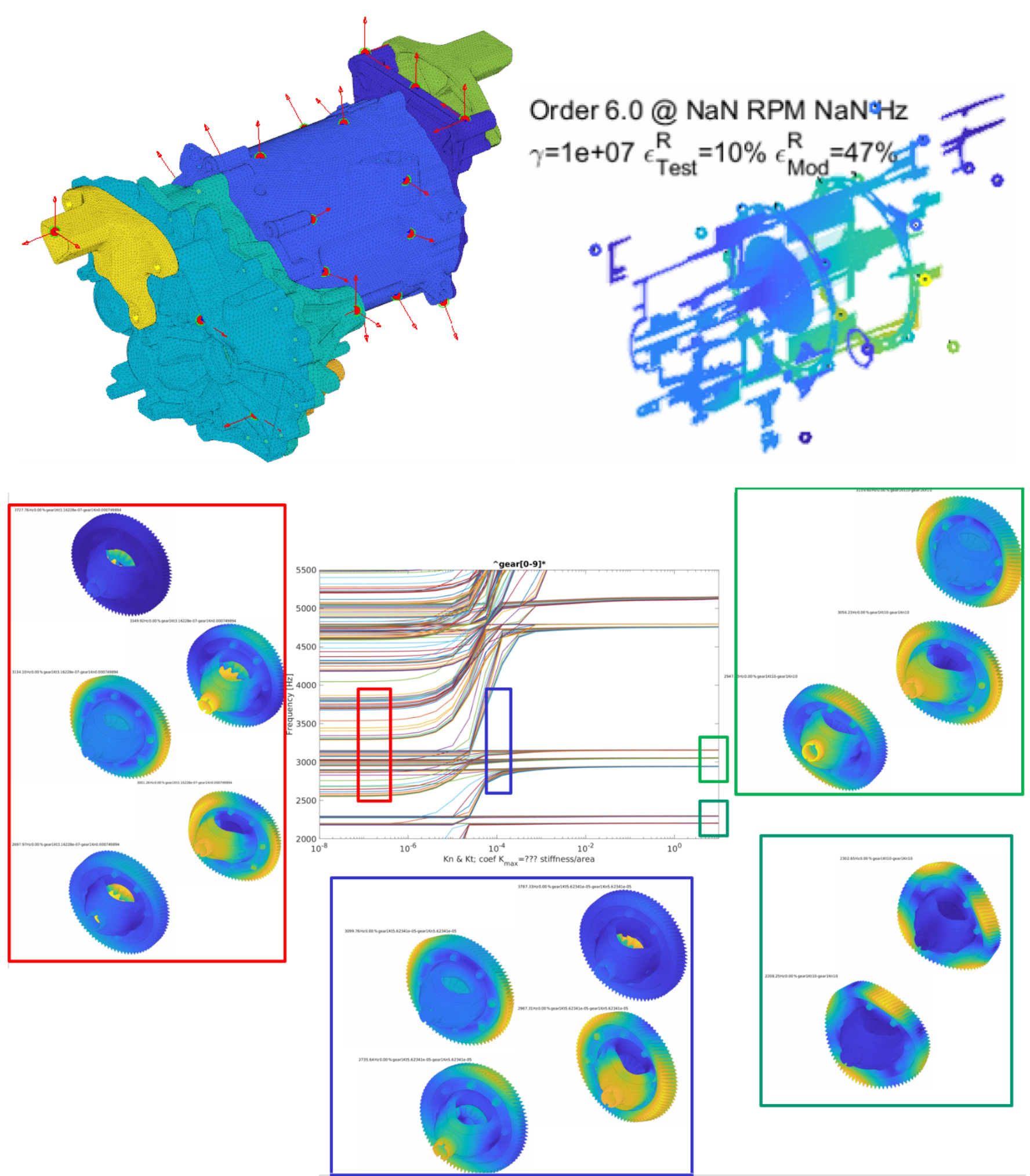 | Hybrid FEM/test twin building, an electric engine case history E. Balmes, G. Vermot Des Roches , S. Nacivet CSMA 2024 Abstract[...]An electric engine case history illustrates issues in the hybrid use of models and test data. Having fast online models for many query evaluations of responses of interest is a traditional topic. Rather than focusing on IA related inverse methodologies, one evaluates the performance of current versions of component mode synthesis leading to direct generation of parametric reduced order models. Discussions address geometry, contact and high modal densities. Finally, model and test errors are considered for hybrid estimations of motion. | #HybridTwin #conference | Download |
 | Analysis of a brake squeal functional model using a linear parameter varying perspective G. Malacrida Alves, E. Balmes, G. Martin INTER-NOISE 2024 Abstract[...]Brake squeal is a limit cycle vibration induced by mode coupling instability that depends on operating conditions such as applied pressure, temperature, and disc velocity. This work proposes a simplified functional model of brake squeal that reproduces the main characteristics observed in a full-scale industrial test campaign: vibration growth, limit cycle saturation, vibration decay and parametric dependence. The proposed functional model differs from the well-known Hoffmann model by the introduction of a nonlinear contact law and a quasi-static pressure loading. First, using a harmonic balance perspective, non-linear forces are shown to lead to a pressure and amplitude dependent contact stiffness. This Linear Parameter Varying perspective allows complex mode computations in the pressure/amplitude domain which are then correlated with a series of transient responses of the nonlinear modes for three different pressure profiles. The chosen profiles represent usual experiments: drag where a constant pressure is applied, pressure ramps and pressure oscillations mimicking the effect of wheel spin on the contact surfaces. | #brake #HBVSig #conference | Download |
 | Parametric modal testing using slow but continuous variation of operating conditions. Illustration on a contact bench. G. Malacrida Alves, E. Balmes, G. Martin, T. Chancelier, E. Kassa SURVISHNO 2023 Abstract[...]Many systems have vibration properties, modes and non-linear limit cycles, that are significantly affected by environmental properties such as temperature, pressure, rotation speed, ... The classical testing strategy is to select a number of fixed operating conditions, wait for the system to stabilize at each condition and extract the vibration characteristics. A lot of test configurations may thus be required to finely characterize the influence of environmental parameters on the system dynamics. The novel point of view taken here is to consider that in a number of applications, one can generate a slow variation of the operating condition that is sufficiently below the frequencies of interest to allow continuous monitoring of vibration properties. The application chosen as illustration of the process is a test bench seeking to characterize contact stiffness properties in a brake subassembly focusing on piston/backplate and piston/chamber contacts. A first rough estimate of the relation between modal frequency and pressure is obtained by traditional modal tests. A series of tests then changes pressure and excitation frequency continuously seeking to track phase resonance and thus update the estimates of resonance frequency, damping and shape changes at a very large number of pressure points. The proposed methodology using a feed-forward approach results in tests that are inherently certain to provide a result in a controlled amount of time | #brake #ParamTesting #conference | Download |
 | A time varying system perspective on rubber mount tests G. Malacrida Alves, E. Balmes ISMA 2022 Abstract[...]Rubber tests typically only consider the first harmonic of responses and thus ignore additional information about variation of properties during a cycle. The Payne effect is then only described as a decrease of modulus with amplitude. An harmonic modulation is introduced as a novel way to look at the classical harmonic balance characterization of periodic signals in an effort to answer the question of when in the period is the system close to being linear ? In the case of enforced displacement tests, the harmonic modulation of force signals corresponds to an instant material stiffness or instant modulus. Sine test results are thus interpreted as trajectories in a complex modulus / strain plane that are much more discriminating than the traditional representation as a complex modulus and gives indication of coupling between hyperelastic, hysteretic and viscoelastic behaviors. This new interpretation of classical results is shown to be relevant as a correlation tool and a constitutive model for rubber is validated in its ability to reproduce the instant modulus behavior in a wide range of cases. | #damping #HBVSig #conference | Download |
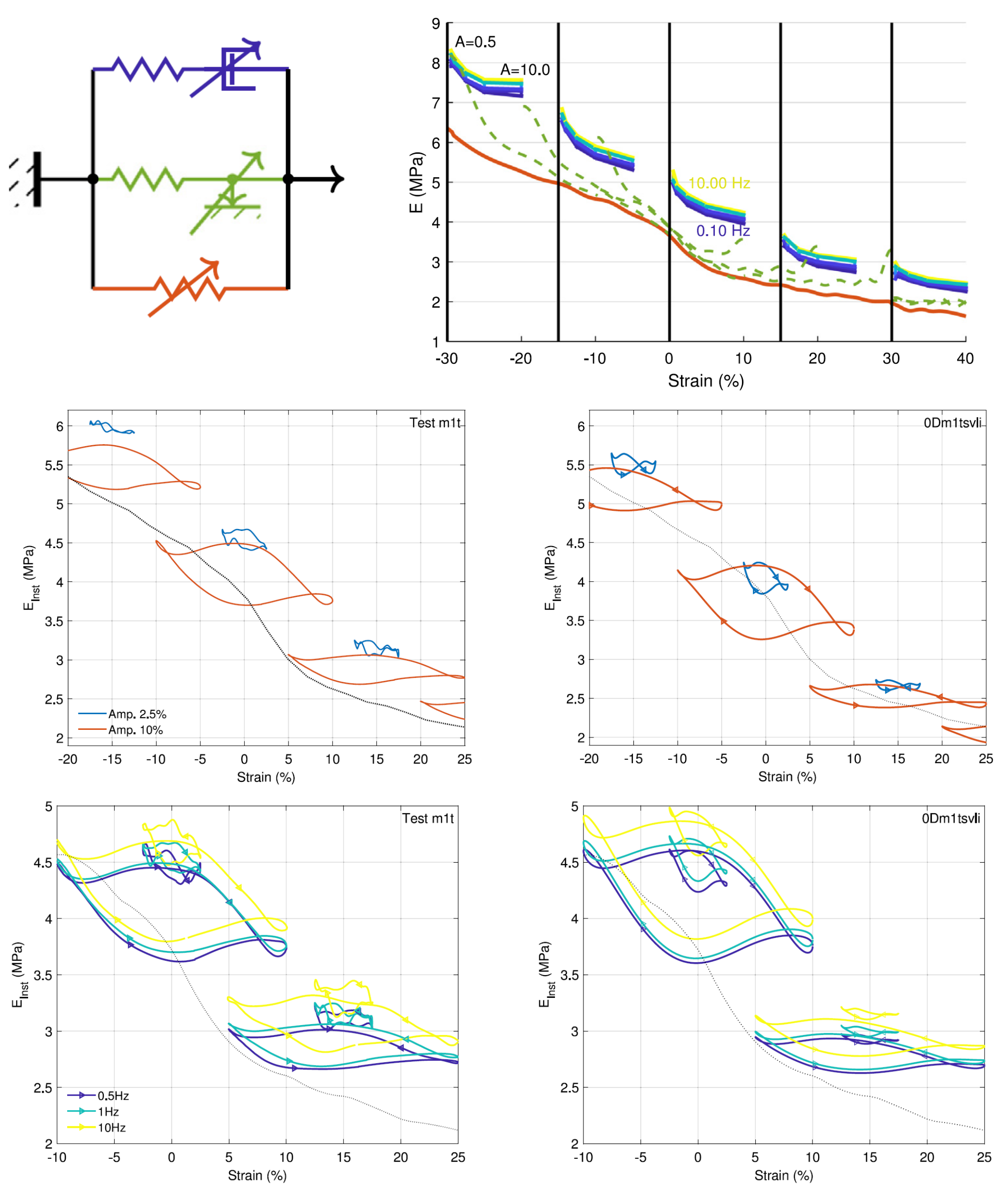 | A unified non-linear system model view of hyperelasticity, viscoelasticity and hysteresis exhibited by rubber R. Penas, E. Balmes, A. Gaudin MSSP 2022 Abstract[...]Rubber modeling is an old subject and so many models exist that it is difficult to have a clear vision of what exists and is more appropriate. Rather than attempting a standard review, this paper proposes classification using the traditional system modeling strategy, where raw measurements are either processed to obtain non-parametric models, or used to identify parametric models, whose accuracy can be controlled by order selection or by numerical implementation considerations. A full test campaign, including multi-step relaxation, low speed triangular and sine tests, on a large deformation compression sample is used to illustrate the need to model and combine the base behaviors known as hyperelasticity, viscoelasticity, and rate independent hysteresis. The equivalence between linear viscoelasticity and linear time invariant systems is used to clarify the link between order selection and accuracy of a generalized Maxwell model. Rate independent hysteresis is analyzed using a convolution product like the one used for viscoelastic transients by introducing a relaxation modulus. Measurements of the hysteretic relaxation modulus are used to propose strategies to measure the asymptotic hyperelastic modulus and discriminate between different hysteretic model forms. A parallel between Iwan and Maxwell models is detailed, and non-parametric models are used to show that the two overlap in the low frequency small deformation regime. Regularized rate independent hysteresis and non-linear viscoelasticity are finally shown to lead to a similar view allowing a transition between the rate independent and linear relaxation models. The instantaneous ratio analytic force and displacement signals, or instant complex modulus, is introduced as novel non-parametric estimation of sine measurements and shown to be a powerful tool to analyze and validate the fact that a force rate relaxation with non-linear relaxation frequencies is most appropriate to represent the non-linear coupling of all three effects. | #damping #journal | Download |
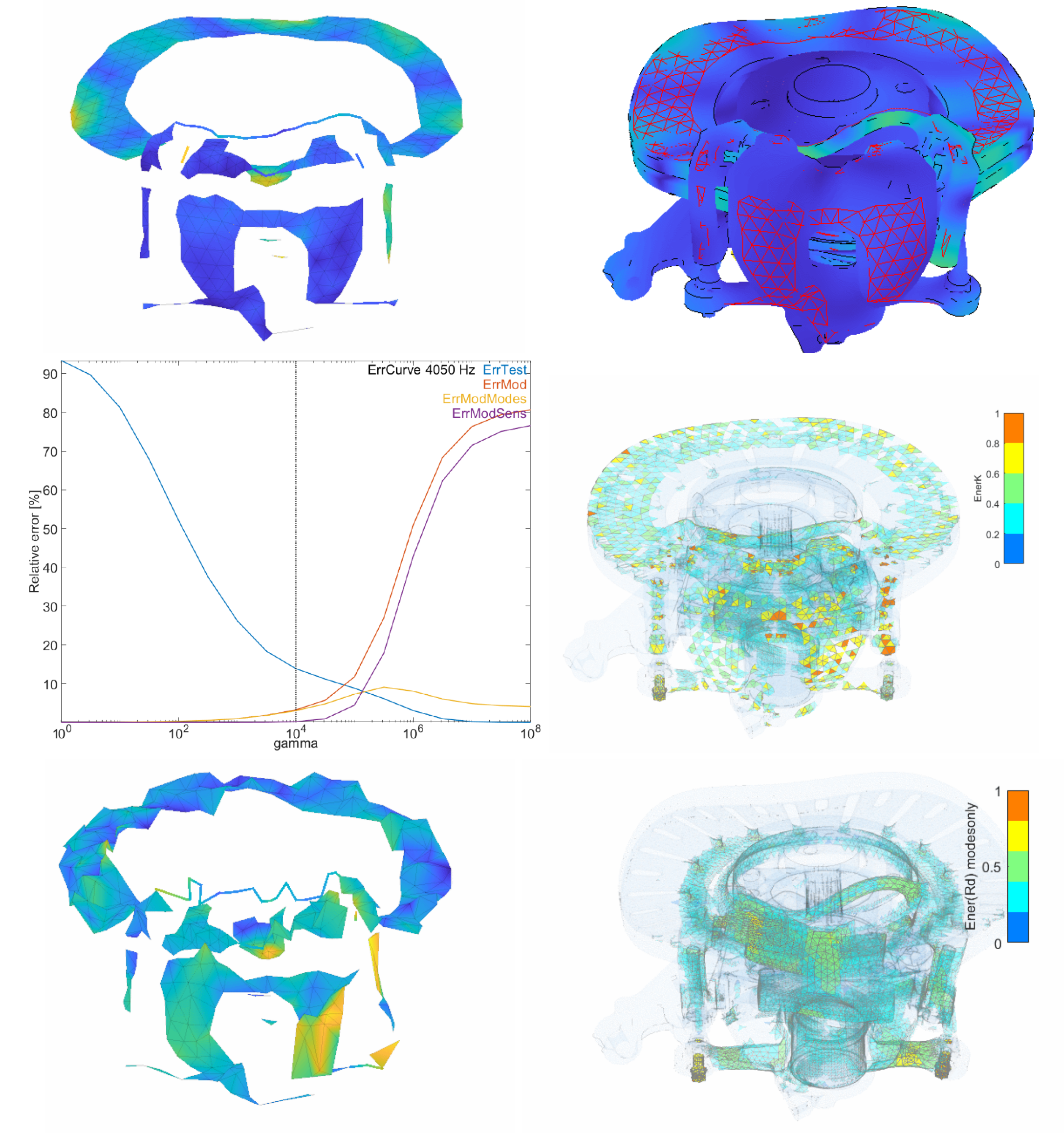 | Expansion in structural dynamics : a perspective gained from success and errors in test/FEM twin building E. Balmes, G.Martin, G. Vermot Des Roches, T. Chancelier, S. Thouviot CSMA 2022 Abstract[...]Since tests only provide measurements at sensors, it is interesting to use models to estimate the response at all degree of freedom, correct measurement errors and possibly allow updating of model parameters. The paper gives an integrated perspective on methods developed by the control and structural dynamics communities and in particular methods seeking a trade-off between test and model error. The case of a measured brake squeal limit cycle is used to illustrate implementation details found to be important. | #brake #HybridTwin #conference | Download |
 | A Structural Dynamics Modification Strategy based on Expanded Squeal Operational Deflection Shapes G. Martin, E. Balmes, T. Chancelier, S. Thouviot, R. Lemaire EUROBRAKE 2022 Abstract[...]To analyze brake squeal, measurements are performed to extract Operational Deflection Shapes (ODS) characteristic of the limit cycle. The advantage of this strategy is that the real system behavior is captured, but measurements suffer from a low spatial distribution and hidden surfaces, so that interpretation is sometimes difficult. It is even more difficult to propose system modifications from test alone. Historical Structural Dynamics Modification (SDM) techniques need mass normalized shapes which is not available from an ODS measurement. Furthermore, it is very difficult to translate mass, damping or stiffness modification between sensors into physical modifications of the real system. On the model side, FEM methodology gives access to fine geometric details, continuous field over the whole system. Simple simulation of the impact of modifications is possible, one typical strategy for squeal being to avoid unstable poles. Nevertheless, to ensure accurate predictions, test/FEM correlation must be checked and model updating may be necessary despite high cost and absence of guarantee on results. To combine both strategies, expansion techniques seek to estimate the ODS on all FEM DOF using a multi-objective optimization combining test and model errors. The high number of sensors compensates for modeling errors, while allowing imperfect test. The Minimum Dynamics Residual Expansion (MDRE) method used here, ensures that the complex ODS expanded shapes are close enough to the measured motion but have smooth, physically representative, stress field, which is mandatory for further analysis. From the expanded ODS and using the model, the two underlying real shapes are mass-orthonormalized and stiffness-orthogonalized resulting in a reduced modal model with two modes defined at all model DOFs. Sensitivity analysis is then possible and the impact of thickness modifications on frequencies is estimated. This provides a novel structural modification strategy where the parameters are thickness distributions and the objective is to separate the frequencies associated with the two shapes found by expansion of the experimental ODS. | #brake #HybridTwin #conference | Download Presentation |
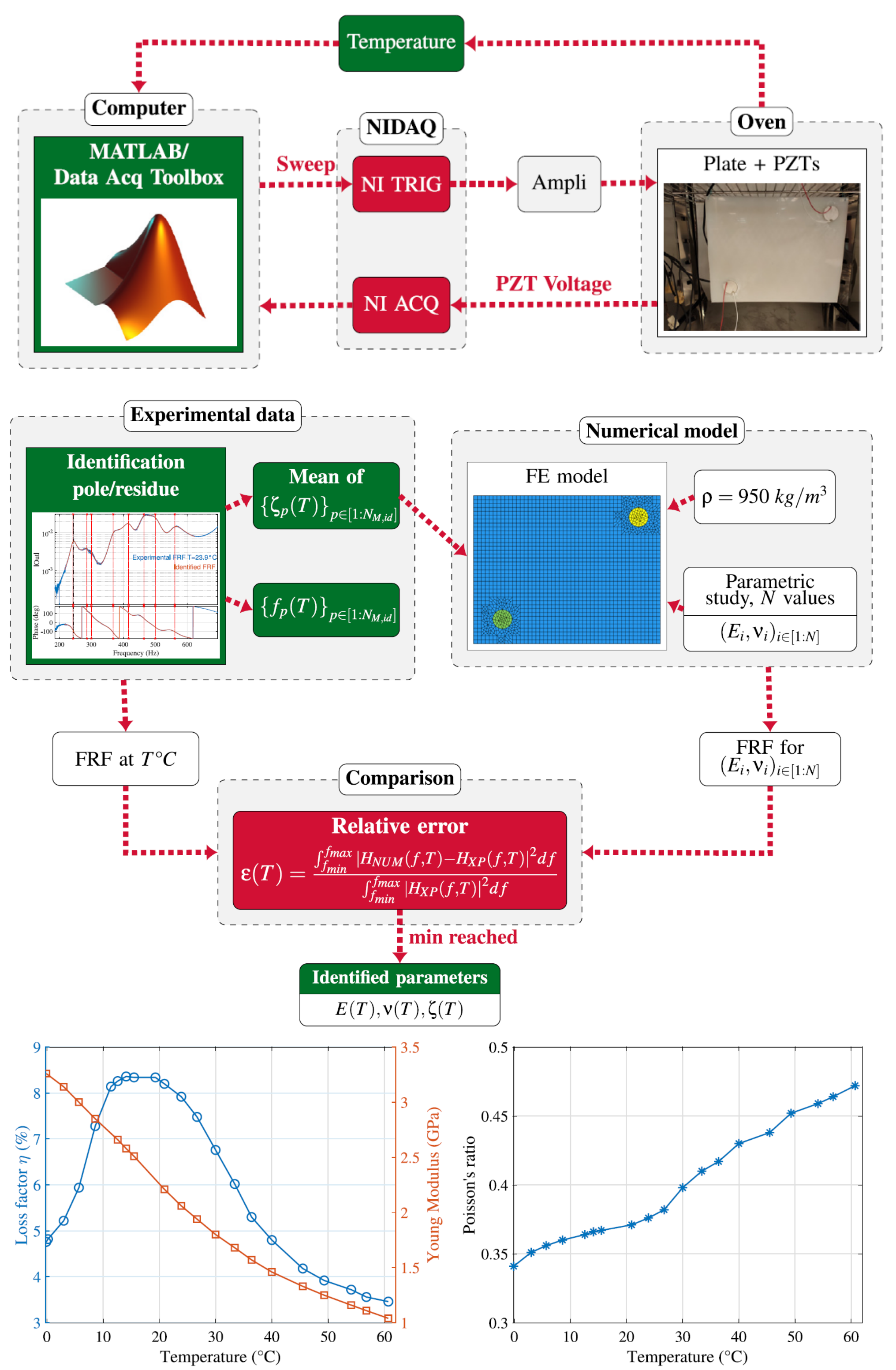 | Bending waves focusing in arbitrary shaped plate-like structures: Study of temperature effects, development of a digital twin and of an associated neural-network based compensation procedure N. Benbara, G. Martin, M. Rébillat, N. Mechbal JSV 2022 Abstract[...]Advanced automotive audio applications are more and more demanding with respect to the visual impact of loudspeakers while still requiring more and more channels for high quality spatial audio rendering. Removing classical heavy and large electrodynamic loudspeakers and using car interior plate-like structures driven by state of the art spatial sound algorithms appear as a promising solution to tackle both issues. However, to meet spatial audio rendering constraints, the bending waves generated within car interior plate-like structures must be focused at a given position and to a certain extent within the host structure. Theoretically, this means being able to invert in a robust manner the spatio-temporal wave propagation operator for the generated bending waves to fit a given target shape. The propagation operator inversion method considered here is the spatio-temporal inverse filtering (STIF) method based on the knowledge of the propagation operator on a regular spatial grid over the structure at a given temperature. However, in a car interior a high temperature variations exist and can adversely impact the performances of the STIF method, mainly because dynamical properties of the host structure (built up with polypropylene in most cases) largely vary within this temperature range. Even if the STIF method has already been adapted and assessed in the context of automotive audio reproduction, no study dealing with the effects of temperature on the STIF method and providing potential mitigation procedures avoiding experimental measurements at each temperature has been reported. To address that issue, the influence of temperature on the behavior of a polypropylene plate is first experimentally quantified. A model updating method is used to build a finite-element model of the plate taking into account temperature effects. This digital twin of the host-structure is then used to assess the influence of the temperature on the STIF method. A neural network based controller is finally trained and validated on the digital twin in order to compensate for the effects of temperature on STIF filters. Obtained results demonstrate that this procedure successfully allows to compensate for temperature effects on the STIF method applied to polypropylene plate with very limited experimental needs, thus paving the way through an industrial development of such approaches. | #ParamTesting #HybridTwin #journal | Download |
 | Viscoelastic homogenization of 3D woven composites with damping validation in temperature and verification of scale separation F. Conejos, E. Balmes, B. Tranquart, E. Monteiro, G. Martin Composite Structures 2021 Abstract[...]Estimation of damping can be of great importance for turbomachines, where vibration based instabilities like flutter occur. The paper discusses a numerical method to predict the homogenized viscoelastic behavior of 3D woven composites, used in fan blades, from elementary constituent behavior. Yarn and weave microstructures are considered in a two scale homogenization. The matrix and fibers are considered homogeneous with linear viscoelastic and elastic behavior respectively. Temperature and frequency dependence of matrix properties are characterized by complex moduli. Confrontation of numerical predictions with modal damping of a modified Oberst experiment, for a temperature range of -40 to 120 °C, gives good results in terms of absolute value and trends. The homogenization is formulated using matrix operations, which enables the simple use of model reduction techniques for parametric studies on temperature and leads to energy fraction analyses useful to gain understanding of how different components of the constitutive laws contribute to damping and change with temperature. Finally, since weaving patterns have a scale of a few centimeters, that is not small compared to gradients found in the experiment, exact solutions for responses to regular volume loads are used to characterize the validity of the scale separation hypothesis as a function of wavelength. | #damping #reduction #ParamTesting #journal | Download |
 | Models of dissipative bushings in multibody dynamics R. Penas Ferreira PhD Thesis 2021 Abstract[...]Multibody simulations are used in the automotive industry to ensure that important design targets are met. A key point in the accuracy of such simulations is the proper modeling of rubber bushings and mounts. Indeed, they do require precise modeling of large deformation for high loading maneuvers, typically associated with active safety, and a correct modeling of dissipation, for most comfort applications. The current modeling process of these mounts and bushings considers tests to generate 0D models in each separate direction with linear viscous dissipation.The tests proposed and realized in this work were used to characterize the effects of large deformation, rate independent hysteresis and viscoelasticity separately. Models for each one of those behaviors are categorized into non-parametric models, extracted directly from data, selected order parametric models, whose accuracy depend on the number of internal states, and order independent models. Utilization of ratios of the nonlinear static branch for all the other branches is shown to be an effective way to model coupling of dissipation with large deformations. Transition between hysteresis and viscoelasticity is presented as a consequence of nonlinear viscoelasticity and provides good agreement with tests demonstrated by the comparison of the proposed instant modulus.The influence of loading in transverse directions on a given axis is very difficult to obtain from tests, yet necessary for accurate bushing models. Finite element computations are quite suitable for such studies, and as they require 3D models, the translation of the proposed 0D model into a 3D material model is detailed. Two different identification routines for both the 3D and 0D models were proposed: one with classic objective functions for the material model and a graphic one with order selection based on the non-parametric models. %Synthetic plots illustrating all behaviors are made for both material and part specimens, reuniting most of the responses.Despite the usefulness of FE routines to link geometry and material behavior, their typical computation times are orders of magnitude too large to be acceptable for the envisioned multibody applications. A combination of kinematic reduction and hyper-reduced integration of the model equations is thus detailed and shown to provide sufficient accuracy and the needed speedup in computation times. The mathematical frame for integrating the reduced 3D models into multibody routines is described.Finally, two multibody illustrations are detailed. The first case highlights the fact that hysteretic and viscous dissipations may lead to notably different transient responses, confirming the need for the propositions made for 0D models. The second one shows that replacing the current relatively coarse 0D models with those developed in this work should induce notable modifications of the response. | #damping #reduction #thesis | Download |
 | Multiscale homogenization for a modal damping objective in the design of 3D woven composite blades F. Conejos PhD Thesis 2021 Abstract[...]The goal of this work is to control the damping of the first modes of the fan blade during the design phase.A numerical method for the viscoelastic homogenization of 3D woven composite materials is developed. Two homogenizations are made, at the yarn's scale and at the woven one. The complex modulus of the resin, the elastic properties of the yarns and the geometry of the microstructure allow a characterization of the damping in frequency and temperature. The matrix formulation of the homogenization, for a finite element implementation, allowed the use of model reduction techniques in parametric studies on the viscoelastic properties of the composite's constituents.A comparison of the numerical predictions with the modal damping obtained by modified Oberst test, for low frequencies and a range of temperature between -40°C and 120°C, provided coherent results in terms of absolute values and trends. These tests also show areas of stress gradient which are small compared to the weaving pattern size motivating the introduction of a verification methodology of the scale separation hypothesis at different wavelengths. The definition of the elastic and dissipated energy fractions by decomposition of the constitutive law into singular values allows an analysis of the main contributions to the damping at both 3D woven and fan blade scale.The insertion of a hybridized 3D woven composite with elastomer tows within the fan blade is proposed in order to increase the modal damping of the first flexion. A spatial study of the areas dissipating the most energy is performed to optimize the placement of the hybrid weaving pattern. | #daming #reduction #thesis | Download |
 | Hyper-reduced models of hyperelastic dissipative elastomer bushings R. Penas, A. Gaudin, E. Balmes ISMA 2020 Abstract[...]Rubber mount modeling in multibody simulation is crucial for accuracy in this type of calculation, and despite its importance, they are often underestimated in terms of modeling. The present work aims to develop and implement a finite element model suited for rubber behavior in large deformations, and apply hyperreduction techniques to evaluate the possibility of a direct implementation into a multibody simulation, or to generate a novel family of joint models. The article begins with the development and implementation of the material behavior, then a brief explanation on the implemented finite elements routine along with the hyper-reduction method used. An analysis of the results and an insight of future developments closes the article. | #damping #reduction #conference | Download |
 | A general superelement generation strategy for piecewise periodic media H. Pinault, E. Arlaud, E. Balmes JSV 2020 Abstract[...]Structures composed of repetitions of multiple identical cells are common and have been the object of a large body of literature on waveguides, periodic media, and cyclic symmetry. Starting from a cell model, possibly with a large number of Degrees of Freedom both inside the cell and on its edges, the objective of this paper is to propose a Ritz-Galerkin reduction procedure retaining the standard second order model form and periodicity properties of the original model, while controlling accuracy in terms of model bandwidth and reproduction of the forced response to applied loads. The procedure is classically decomposed in two phases: subspace learning and basis generation. For the learning phase, Wave Finite Element (WFE) and periodic computations are presented as alternatives. The latter are then preferred for their easier control on the reduced model accuracy using classical modal synthesis and the simple choice of few target wavelengths. For the basis generation phase, constraints needed to generate a periodic superelement are defined and numerical procedures to generate a basis verifying those constraints are proposed. The validity of the reduction is demonstrated for the case of a cell with random elastic properties presenting bandgaps, local modes and wavemode crossing. Accurate predictions of modes and damped forced response are given for both the infinite and finite cases, using frequency and time simulations. The proposed analysis illustrates tracking of waveshapes, evaluation of significant waves by computation of the forced response in the frequency/wavenumber domain and interpretation of the relation between the infinite and finite forced responses. The case of a railway track with edges and transitions between multiple periodic zones is finally used to illustrate scalability issues. | #rail #reduction #journal | Download |
 | Reduction with multi-wavelength learning for open or heterogeneous waveguides : application to railway track dynamics H. Pinault PhD Thesis 2020 Abstract[...]The main goal of this work is to propose a waveguide model representing the whole length to handlethe variability between geometrically periodic cells, suited to time-based computations to deal with non-linearities,and with reduction to allow simulations in a time sufficiently small for use in a design group. The analysis ofwaveguides is a recurring subject in the literature. Bloch-Floquet theory is often used to compute solutions definedon a reference cell at several wavenumbers. However, this formulation does not allow variability between periodiccells, is not suited for time-based computations, and may lead to a significant numerical cost if the interface betweencells is large. To address these limitations, a reduction strategy is proposed, based on the building of a learningsubspace from computed static and modal forms within a frequency range of interest, and for few wavenumbers. Amodel of the full guide is built from reduced cell models and can account for variability. By adjusting the extremecells of the model, this strategy can be adapted for both finite and infinite periodic structures.This reduction strategy is applied to the study of a heterogeneous periodic structure, generated from randomfields. The presence of frequency bandgaps and local modes is assessed. The learning phase manages to takecorrectly these phenomena into account. The strategy is extended to non-periodic heterogeneous structures bycombining several periodic samples.Another goal is to approach radiation in an open medium with absorbing PML boundaries, while maintainingthe possibility to achieve both time and frequency-based computations, which is a requirement of the reductionstrategy. To that end, a FEM implementation with 3D wave attenuation is detailed. The frequency-based analysis ofthis formulation raising contionning issues, conditions are proposed that are sufficient avoid the problem. Theapplication case of a train pass-by on a track shows another limitation : a wrong asymptotic behavior at lowfrequencies.For each of the three main topics, the proposed methodologies are applied to railway track models. They give abetter understanding of the behavior of ballasted or discontinuous slab tracks at low frequencies. | #reduction #thesis | Download |
 | Dissipation in hysteretic rubber mount models R. Penas, A. Gaudin, A. Kreis, E. Balmes ECCMR 2019 Abstract[...]Rubber mounts are elements of extreme importance in automotive suspension, and accurate modeling is crucial for comfort design. While mount characterization is typically done using cycles, actual performance is often associated with transients. The paper thus focuses on the impact of power dissipation on suspension models during transients. For scalar or 0D hysteretic models that respect Madelung rules and Masing’s law, a method is introduced to compute instant dissipation even for models where it is not explicitly available. It is shown that stiffness and dissipation depend only on the last turning point and this dependence should be the core aspect for identifying and modeling hysteretic dissipation. The second section introduces two different 0D models having the same full cycle dissipation and force amplitude, thus the same storage and loss moduli in a first harmonic approximation of the mount behavior, though having different instantaneous dissipation. The case of a transient starting torque soliciting a suspended powertrain is finally considered. The different suspension models are shown to have different instant dissipation which might deeply modify the conclusions drawn from the dynamic simulation. | #damping #reduction #conference | Download |
 | MDRE: an efficient expansion tool to perform model updating from squeal measurements G. Martin, G. Vermot Des Roches, E. Balmes, T. Chancelier Eurobrake 2019 Abstract[...]In brake FEM, model updating is often needed to improve the model accuracy and well describe problematic phenomena such as the squeal. To avoid performing a full model updating which is often time consuming, the use of the Minimum Dynamic Residual Expansion method is proposed to help building the updating strategy. The procedure proposed in this paper is evaluated on a disc brake system, using experimental measurements and the nominal model as input data. From experimental squeal measurements, two shapes are extracted and expanded on the current model. The evaluation of the residual error of model shows areas where the model is wrong and guides through the definition of sensitive parameters which need to be updated. Once the model is parameterized, a model reduction strategy is proposed for further computations to be performed in a time compatible with industrial processes. A parametric study is then achieved: the expansion is computed for all the combinations of the chosen parameters. It is finally possible to navigate through the expansion results for all the parameters, evaluate the evolution of the model accuracy and extract the best combination which improves the model representability. | #brake #HybridTwin #conference | Download |
 | Automatic damage type classification and severity quantification using signal based and nonlinear model based damage sensitive features M. Ghrib, M. Rébillat, G. Vermot des Roches, N. Mechbal Journal of Process Control 2019 Abstract[...]Structural health monitoring (SHM) is an emerging technology designed to automate the inspection process undertaken to assess the health condition of structures. The SHM process is classically decomposed into four sequential steps: damage detection, localization, classification, and quantification. This paper addresses damage type classification and severity quantification issues as classification problems whereby each class corresponds to a given damage type or a certain damage extent. A Support Vector Machine (SVM) is used to perform multi-class classification task. Classically, Signal Based Features (SBF) are used to train SVMs when approaching SHM from a machine learning perspective. In this work, starting from the assumption that damage causes a structure to exhibit nonlinear response, it is investigated whether the use of Nonlinear Model Based Features (NMBF) increases classification performance. NMBF are computed based on parallel Hammerstein models which are identified with an Exponential Sine Sweep (ESS) signal. A study of the sensitivity of classification performance to the noise contained in output signals is also conducted. Dimension reduction of features vector using Principal Component Analysis (PCA) is carried out in order to find out if it allows robustifying the classification/quantification process suggested in this work. Simulated data on a cantilever beam with various damage types and severities as well as experimental data coming from a composite aeronautic plate with various damage severities generated with a unique and original laser process are considered for demonstration. For both application cases, results show that by introducing NMBF, classification performance is improved. Furthermore, PCA allows for high recognition rates while reducing features vector dimension. | #SHM #journal | Download |
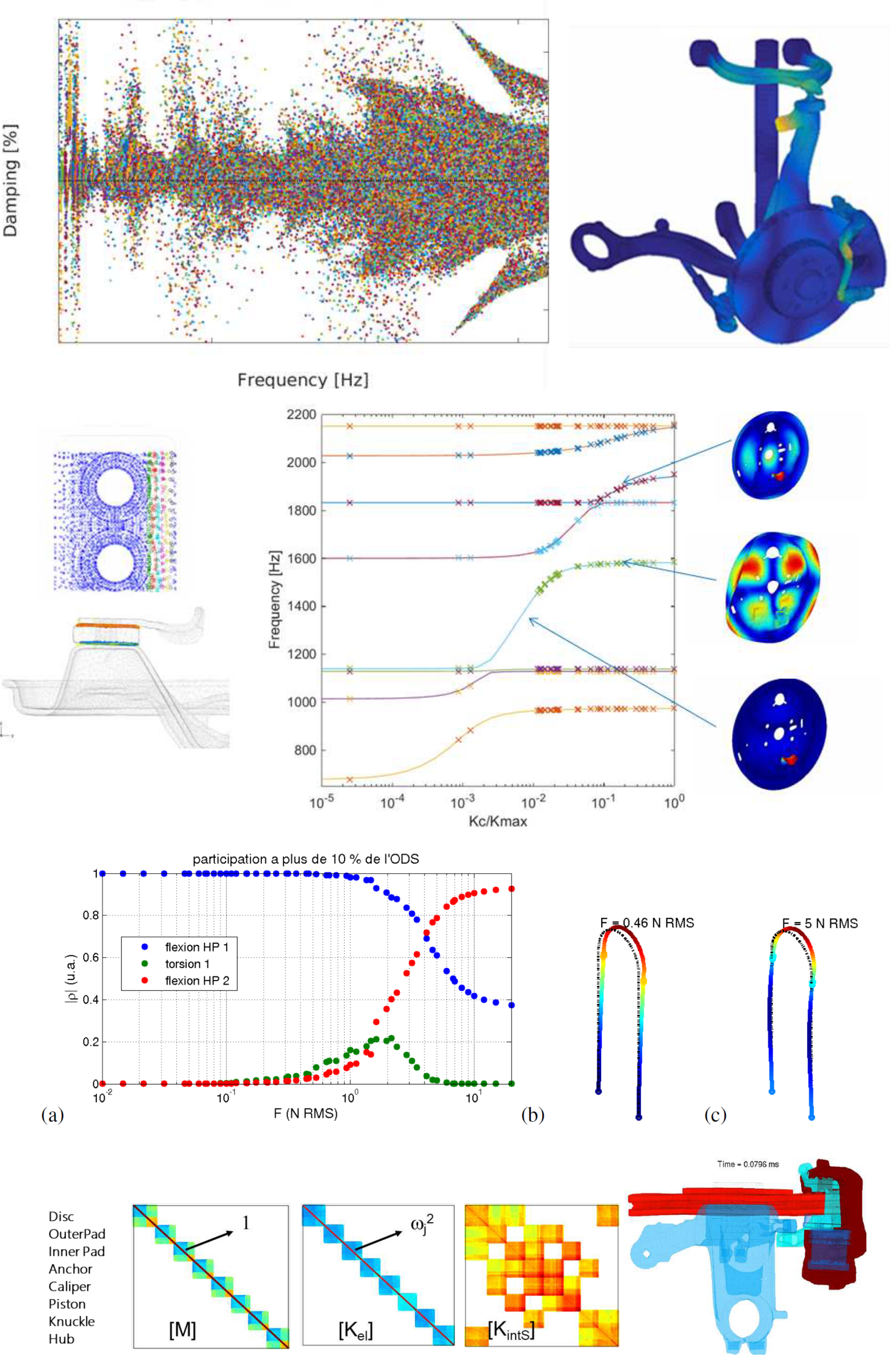 | Shapes & DOF: on the use of modal concepts in the context of parametric non-linear studies E. Balmes ISMA 2018 Abstract[...]Physical responses tend to lie within restricted subspaces even for parametric problems. For a given subspace, the choice of a basis defines Degree Of Freedom (DOF) and this choice may give interesting meaning to the associated amplitudes. Classical modal analysis builds subspaces combining modeshapes and static responses. Parametric loads for non-linear, damped, variable, ... structures are discussed to extend the theory and illustrated for test and simulation cases. Challenges in shape extraction and basis generation techniques are then detailed. Introducing the ability to manipulate models with variable junction properties, component material and geometry, load and operating conditions, ... opens new questions on the quantification and tracking of changes and objectives throughout design exploration. The definition of a reference linear system and the use of global and/or local modal DOF are shown to provide an interesting perspective. | #reduction #conference | Download |
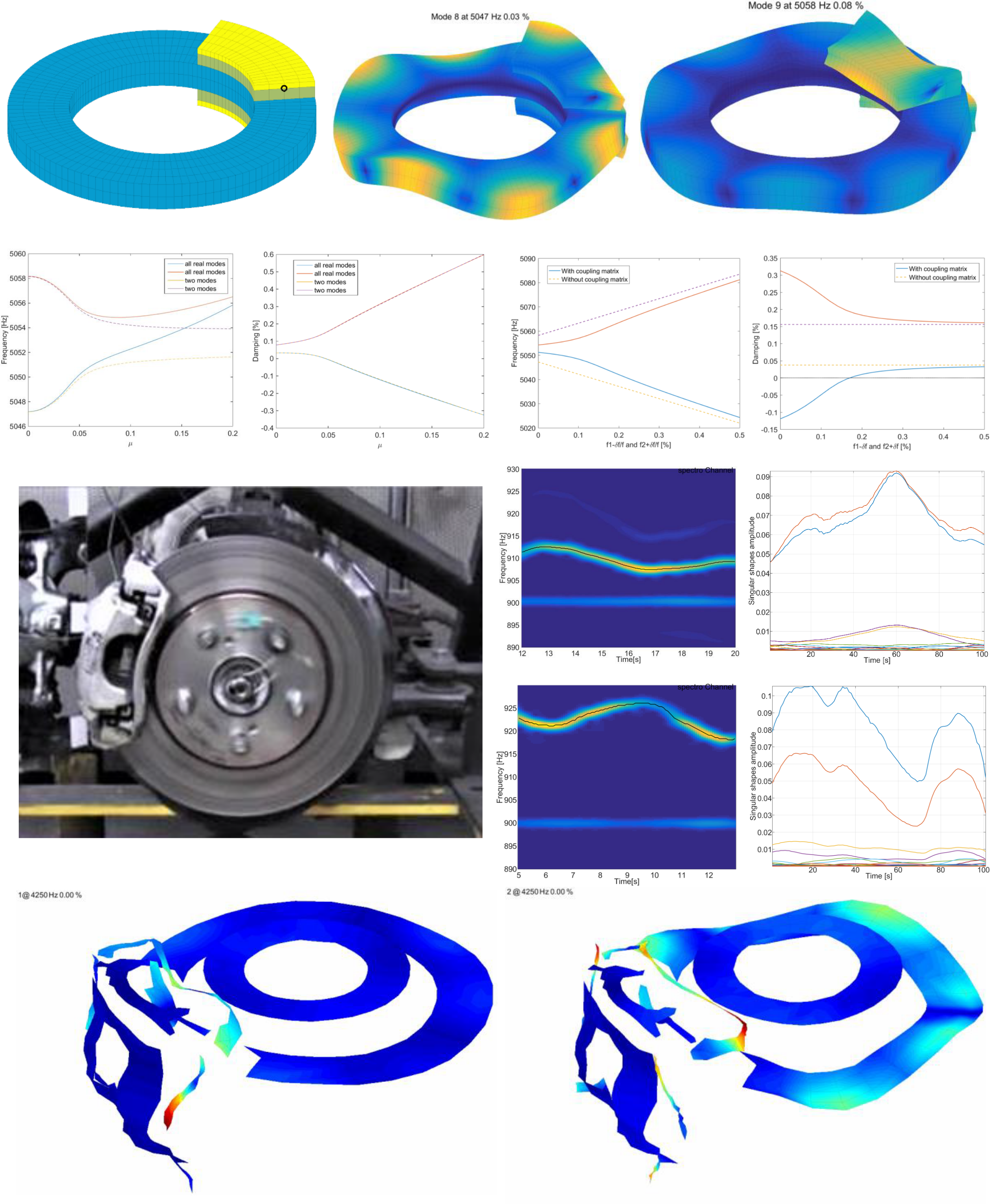 | Squeal measurement with 3D Scanning Laser Doppler Vibrometer: handling of the time varying system behavior and analysis improvement using FEM expansion G. Martin, T. Chancelier, G. Vermot des Roches, E. Balmes ISMA 2018 Abstract[...]In the presence of squeal, Operational Deflection Shapes (ODS) are classically performed to analyze behavior. A simple numeric example is used to show that two real shapes should dominate the response. This justifies an ad-hoc procedure to extract main shapes from the real brake time measurements. The presence of two shapes is confirmed despite variations with wheel position and reproducibility tests. To obtain a high spatial density measurement, 3D Scanning Laser Doppler Vibrometer is interesting but leads to iterative measurements on a time-varying system. An algorithm to merge sequential measurement and extract main shapes is detailed. Even with a high-density 3D SLDV measurement, shapes characterizing the squeal event are still only known on accessible surfaces. Minimum Dynamic Residual Expansion (MDRE) is thus finally used to estimate motion on a full FE mesh which eases interpretation and highlights areas where the test and the model contain errors. | #brake #HybridTwin #conference | Download |
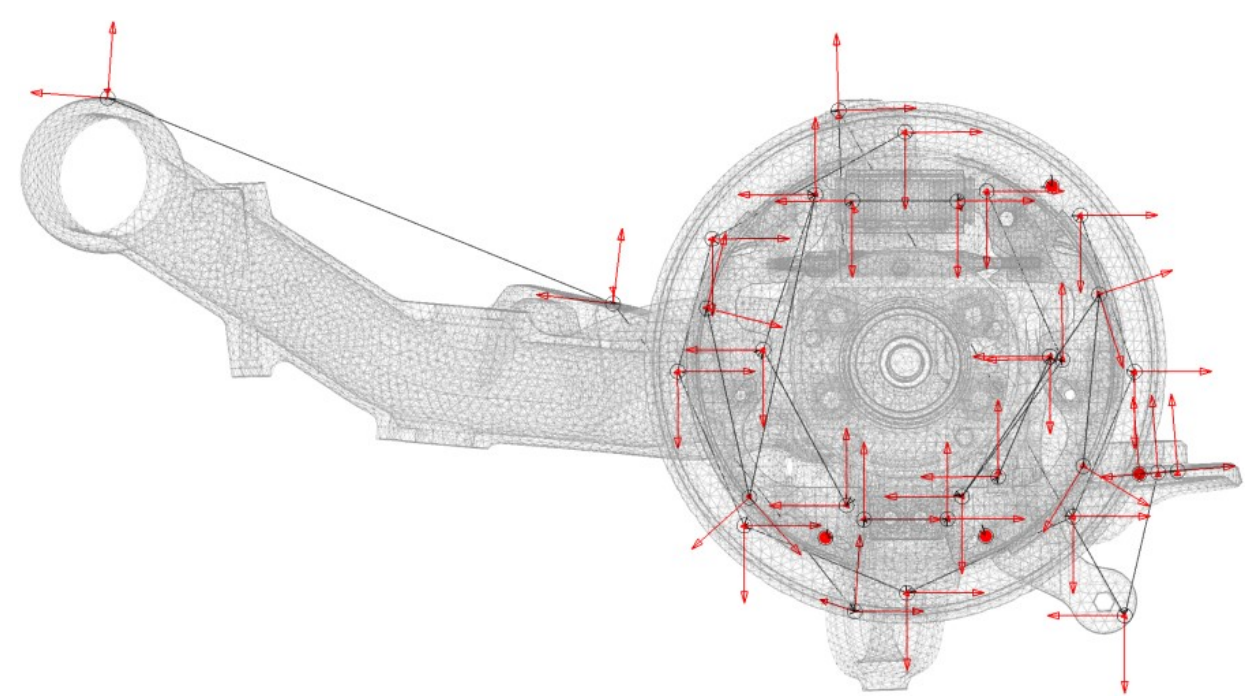 | Squeal measurement using operational deflection shape. Quality assessment and analysis improvement using FEM expansion G. Martin, E. Balmes, G. Vermot des Roches, T. Chancelier Eurobrake 2017 Abstract[...]In presence of squeal, Operational Deflection Shapes (ODS) are classically measured to gain understanding of brake behavior. A simple numeric example is analyzed to justify the use of time-frequency analysis and shows that two real shapes should probably dominate the response. Using measurements on a real brake, this expectation is shown to hold even in the presence of variations with wheel position as well as for reproducibility tests. For a proper relation with the model, it is desirable to also extract modes. The test campaign is used to illustrate how this can be quite difficult due to reproducibility problems. Finally, shapes characterizing the squeal event are fundamentally limited by measurable quantities. Minimum Dynamic Residual Expansion (MDRE), which estimates test motion at all FE degrees of freedom, is shown to be applicable for industrial models and gives insight of test and model imperfections. | #brake #HybridTwin #conference | Download |
 | Characterization of identification errors and uses in localization of poor modal correlation G. Martin, E. Balmes, T. Chancelier MSSP 2017 Abstract[...]While modal identification is a mature subject, very few studies address the characterization of errors associated with components of a mode shape. This is particularly important in test/analysis correlation procedures, where the Modal Assurance Criterion is used to pair modes and to localize at which sensors discrepancies occur. Poor correlation is usually attributed to modeling errors, but clearly identification errors also occur. In particular with 3D Scanning Laser Doppler Vibrometer measurement, many transfer functions are measured. As a result individual validation of each measurement cannot be performed manually in a reasonable time frame and a notable fraction of measurements is expected to be fairly noisy leading to poor identification of the associated mode shape components. The paper first addresses measurements and introduces multiple criteria. The error measures the difference between test and synthesized transfer functions around each resonance and can be used to localize poorly identified modal components. For intermediate error values, diagnostic of the origin of the error is needed. The level evaluates the transfer function amplitude in the vicinity of a given mode and can be used to eliminate sensors with low responses. A Noise Over Signal indicator, product of error and level, is then shown to be relevant to detect poorly excited modes and errors due to modal property shifts between test batches. Finally, a contribution is introduced to evaluate the visibility of a mode in each transfer. Using tests on a drum brake component, these indicators are shown to provide relevant insight into the quality of measurements. In a second part, test/analysis correlation is addressed with a focus on the localization of sources of poor mode shape correlation. The MACCo algorithm, which sorts sensors by the impact of their removal on a MAC computation, is shown to be particularly relevant. Combined with the error it avoids keeping erroneous modal components. Applied after removal of poor modal components, it provides spatial maps of poor correlation, which help localizing mode shape correlation errors and thus prepare the selection of model changes in updating procedures. | #HybridTwin #journal | Download |
 | Waves, modes and properties with a major impact on dynamic pantograph-catenary interaction O. Vo Van, J.P. Massat, E. Balmes JSV 2017 Abstract[...]Understanding the dynamic behavior of the pantograph-catenary system is crucial for design improvement, but many factors inuence the contact force, which is the main design objective. To give a proper un-derstanding of dynamic characteristics, the paper uses a combination of mass drop tests on a catenary, analytic models and parametric _nite element model simulations allowing a ne analysis of the inuence of train speed. The _rst contributor to contact force variations is the geometry of the catenary under gravity loading. This parameter is however shown to be insu_cient to explain higher frequency e_ects. The second contributor is the propagation of waves in the contact and messenger wires. The inuence of wave dis-persion is _rst demonstrated, which emphasizes the importance of considering the bending sti_ness. Wave compensation by droppers and reections at the mast are then shown to be important. Characteristic times associated with wave group velocities are _nally used to explain the series of harmonic contributions visible in spectra in the catenary and pantograph frames. Finally, modes are shown to play a role particularly when their frequencies coincide with other contributions. The notion of mode groups, associated wave velocities and relevant design variables are discussed. Several observations pave the way for future work on catenary design. | #panto #journal | Download |
 | Calculation/Test methods for the analysis squeal G. Martin PhD thesis 2017 Abstract[...]Brake squeal is a nuisance commonly encountered in the car industry which often results in financial penalties towards brake manufacturers, even if no robust solution exists for the conception. Numerical simulation and experimental characterizations are the classical two-track approaches to analyze squeal phenomena. Numerical simulation allows a fine analysis of vibration behaviors and the evaluation of conception modification impacts, but models are not perfect and their validity domain must be defined. Measurement guarantees that every parameter is taken into account, but it is often spatially poor and not really suited for modification prediction. In this context, the thesis objectives are to make an overview of test operating methods, to provide tools allowing an easier interaction between both test and simulation teams and to enforce the developments in a business application.After a review of the hypotheses and methods for modal identification, a critical analysis of the identification results leads to the characterization of biases and the introduction of detailed criteria to evaluate the quality of the result. Calculation/test correlation allows to qualify the models and tools are integrated to facilitate its implementation. Several criteria are defined to highlight the sources of bad correlation coming from the measure on the one hand and the model on the other hand. Sources of poor correlation are also identified with the MDRE expansion algorithm, whose limitations are compared with those of static and dynamic expansions.Model updating is then processed by a systematic procedure imbricating the steps of updating of geometry, material properties and contacts between components. A contact parametrization is proposed with a multi-model reduction allowing calculation times compatible with industrial time. It also allows sensitivity studies with the introduction of the notion of component modes in an assembly.Finally, a detailed analysis of a measurement campaign on a braking system under squeal conditions is carried out. A parallel between the changes of the limit cycle and the degree of coupling of the complex modes is proposed. In the time-frequency domain, variability, repeatability, reproducibility and the ability to aggregate sequential measurements are evaluated. The result is finally extended on the finite element model, which allows useful interpretations. | #brake #HybridTwin #thesis | Download |
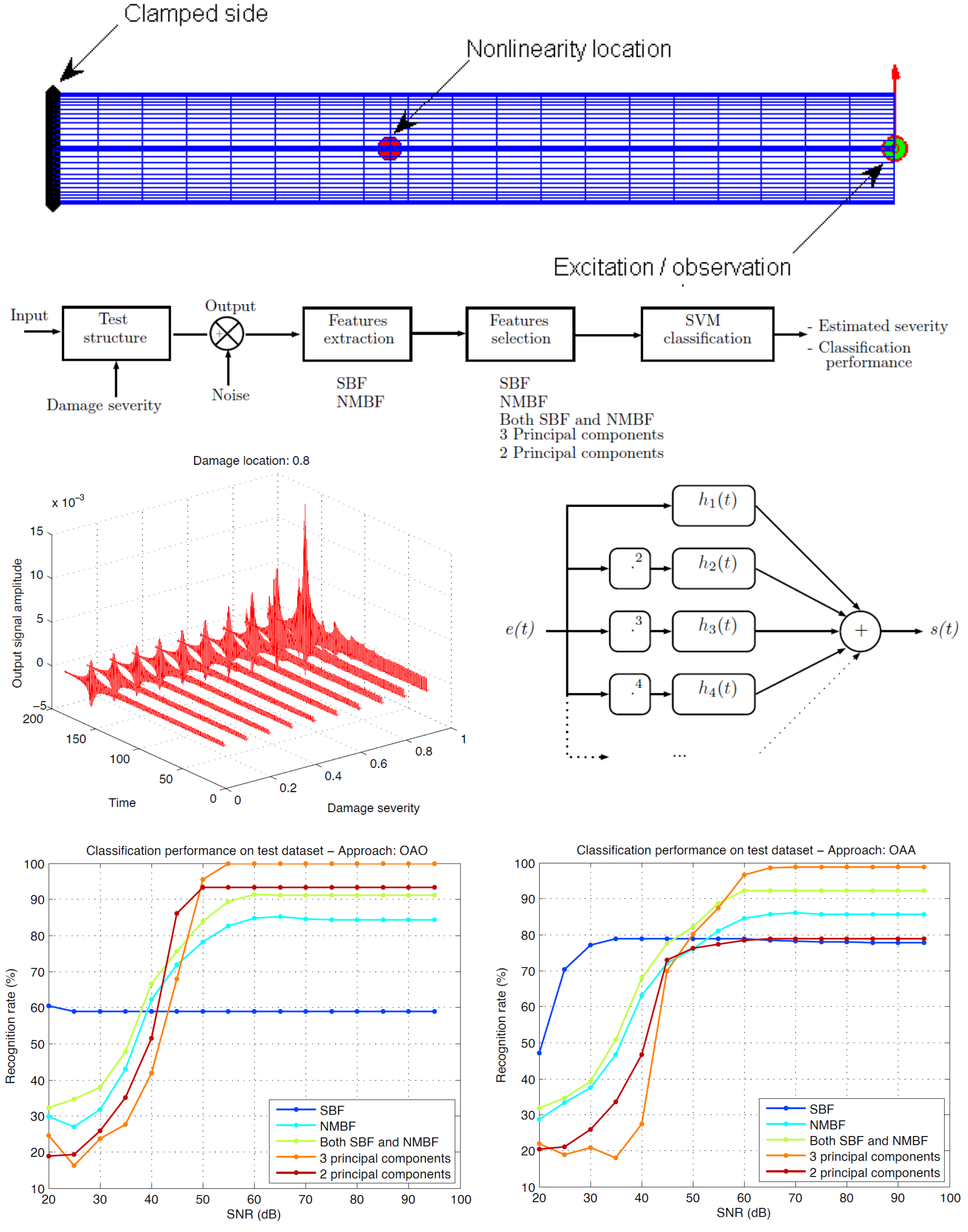 | Automatic Damage Quantification Using Signal Based And Nonlinear Model Based Damage Sensitive Features M. Ghrib, M. Rebillat, N. Mechbal, G. Vermot IFAC 2017 Abstract[...]Structural Health Monitoring (SHM) can be defined as the process of acquiring andanalyzing data from on-board sensors to evaluate the health of a structure. Classically, an SHM process can be performed in four steps: detection, localization, classification and quantification.This paper addresses damage quantification issue as a classification problem where by each class corresponds to a certain damage extent. Starting from the assumption that damage causes a structure to exhibit nonlinear response, we investigate whether the use of nonlinear model based features increases classification performance. A support Vector Machine (SVM) is used to perform multi-class classification task. Two types of features are used as inputs to the SVM algorithm: Signal Based Features (SBF) and Nonlinear Model Based Features (NMBF). SBF are rooted in a direct use of response signals and do not consider any underlying model of the test structure. NMBF are computed based on parallel Hammerstein models which are identified with an Exponential Sine Sweep (ESS) signal. A study of the sensitivity of classification performance to the noise contained in output signals is also conducted. Dimension reduction of features vector using Principal Component Analysis (PCA) is carried out in order to find out if it allows robustifying the quantification process suggested in this work. Simulation results on a cantilever beam with a bilinear torsion spring stiffness are considered for demonstration. Results show that by introducing NMBF, classification performance is improved. Furthermore, PCA allow sfor higher recognition rates while reducing features vector dimension. However, classifiers trained on NMBF or on principal components appear to be more sensitive to output noise than those trained on SBF. | #SHM #conference | Download |
 | Wave damping and evanescence: how to combine the spatial and temporal visions of the same problem? E. Balmes, M. Rebillat, E. Arlaud VISHNO 2016 Abstract[...]It is proposed to analyze the forced response of periodic structures using a 2D Fourier transform using continuous time and discrete space.The simple example of compression waves is used to show that this response can be used to define poles in the wavenumber domain corresponding to evanescent waves or poles in the frequency domain corresponding to damped periodic modes. Link with classical computational methods based on FEM models of cells was done for both the periodic solution and wave based approach (SAFE, WFE). Two examples are analyzed in more detail: a simple train track model exhibiting a band-gap and the more complex case of a honeycomb panel where cell wall bending occurs within the band of interest. | #damping #conference #rail | Download |
 | Updating and design sensitivity processes applied to drum brake squeal analysis G. Martin, E. Balmes, G. Vermot des Roches, T. Chancelier Eurobrake 2016 Abstract[...]Squeal occurrences are quite common in brakes in production and involve coupling of modes. Detailed understanding of vibration patterns typically requires FEM models updated using test results. The process used at Chassis Brakes International typically starts by updating components so that the main sources of variability are associated with junctions. A modeling strategy allowing the practical analysis of the impact of junctions is proposed and illustrated on the case of a drum brake assembly. As the level of uncertainty/design freedom is fairly large for junctions, the evolution of modal properties is difficult to interpret. The notion of component modes within a rigid assembly is thus introduced and shown to provide an appropriate interpretation of changes in a system with multiple modal crossings. The analysis of possible forced responses is finally shown to lead to relevant interpretation of possibly interesting designs or problematic instances of a variable component. | #HybridTwin #conference #brake | Download |
 | Error localization and updating of junction properties for an engine cradle model G. Vermot des Roches, E. Balmes, S. Nacivet ISMA 2016 Abstract[...]Extending the bandwidth of validity of FEM models used in vibroacoustic design is a generic objective of model generation processes. Achieving this objective requires a critical review of both testing and modeling processes. Using the case study of an engine cradle, tools used to detect modal test inconsistencies are first illustrated. On the modeling side, weld spots and lines and variations of thickness due to press forming are shown to have relatively minor impact when compared to the contact surfaces. Usual junction simplifications are also shown to play a major role particularly at higher frequencies where more localized modeshapes occur. | #HybridTwin #conference | Download |
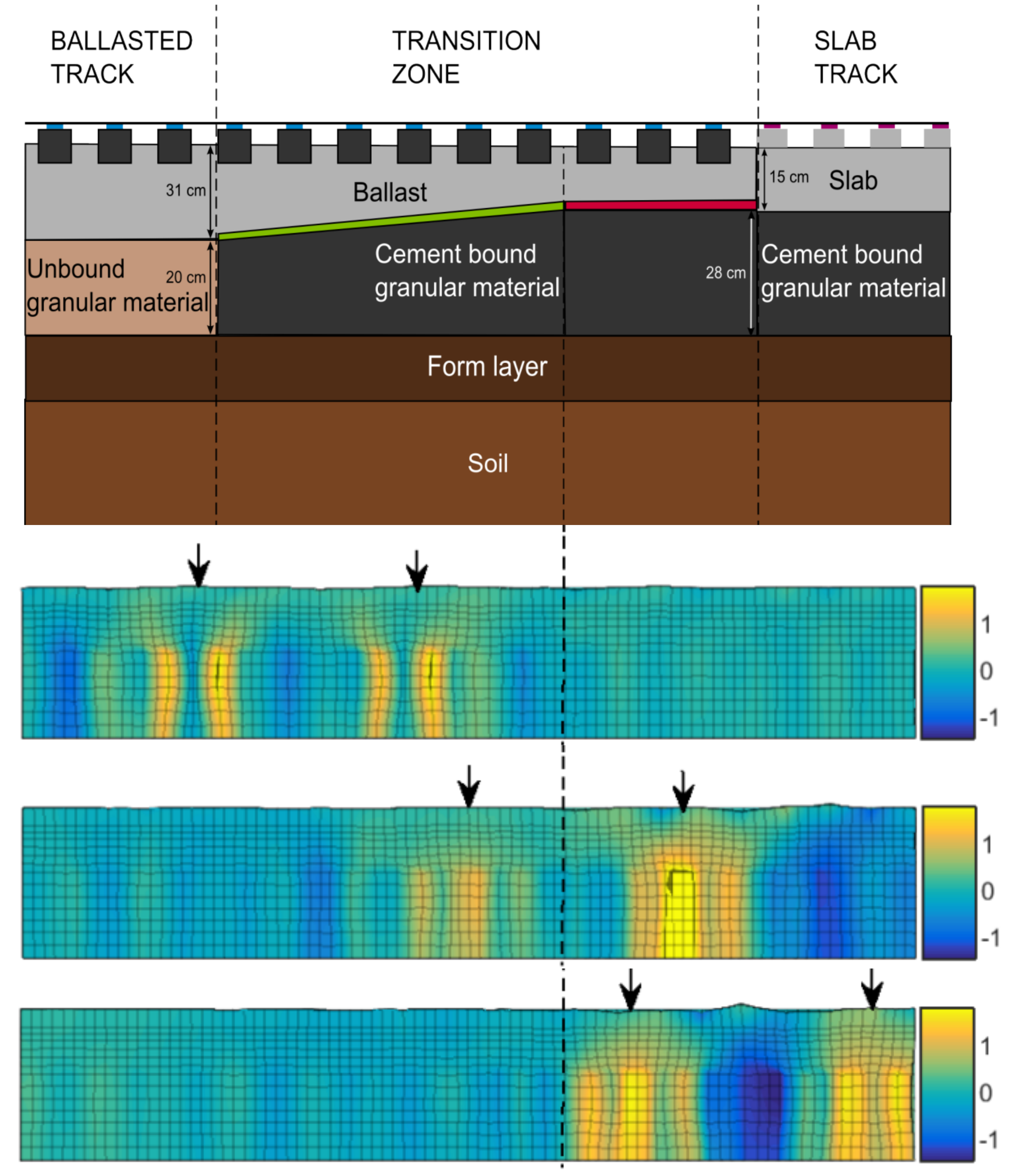 | Numerical Study of Railway Track Dynamics : Case of a Transition Zone E. Arlaud, S. Costa d'Aghuiar, E. Balmes, G. Faussurier Railways 2016 Abstract[...]The main objective of this paper is to present an innovative numerical tool to represent the track and platform dynamic behavior under passing trains. Dynavoie is currently being developed for engineering purposes at SNCF. It is specifically designed to correctly reproduce the track and platform dynamic behaviors in the time domain. This model is based on the Finite Element Method (FEM), adapted to the railway track using model reduction techniques. Taking advantage of the periodicity of the track introduced by the regular sleeper spacing, one or several basic slices containing all the geometric properties of the structure can be identified. Static and periodic responses of these slices are computed. Then, reduction is performed using these deformations.Thus the number of degrees of freedom of the model is highly reduced. This reduction induces a decrease in computation time with limited accuracy loss in the representation of track dynamics. The methodology will be further described in this paper. The second novelty of this work is to use this model to analyze the dynamic behavior of a transition zone located in a French high speed line. | #reduction #conference #rail | Download |
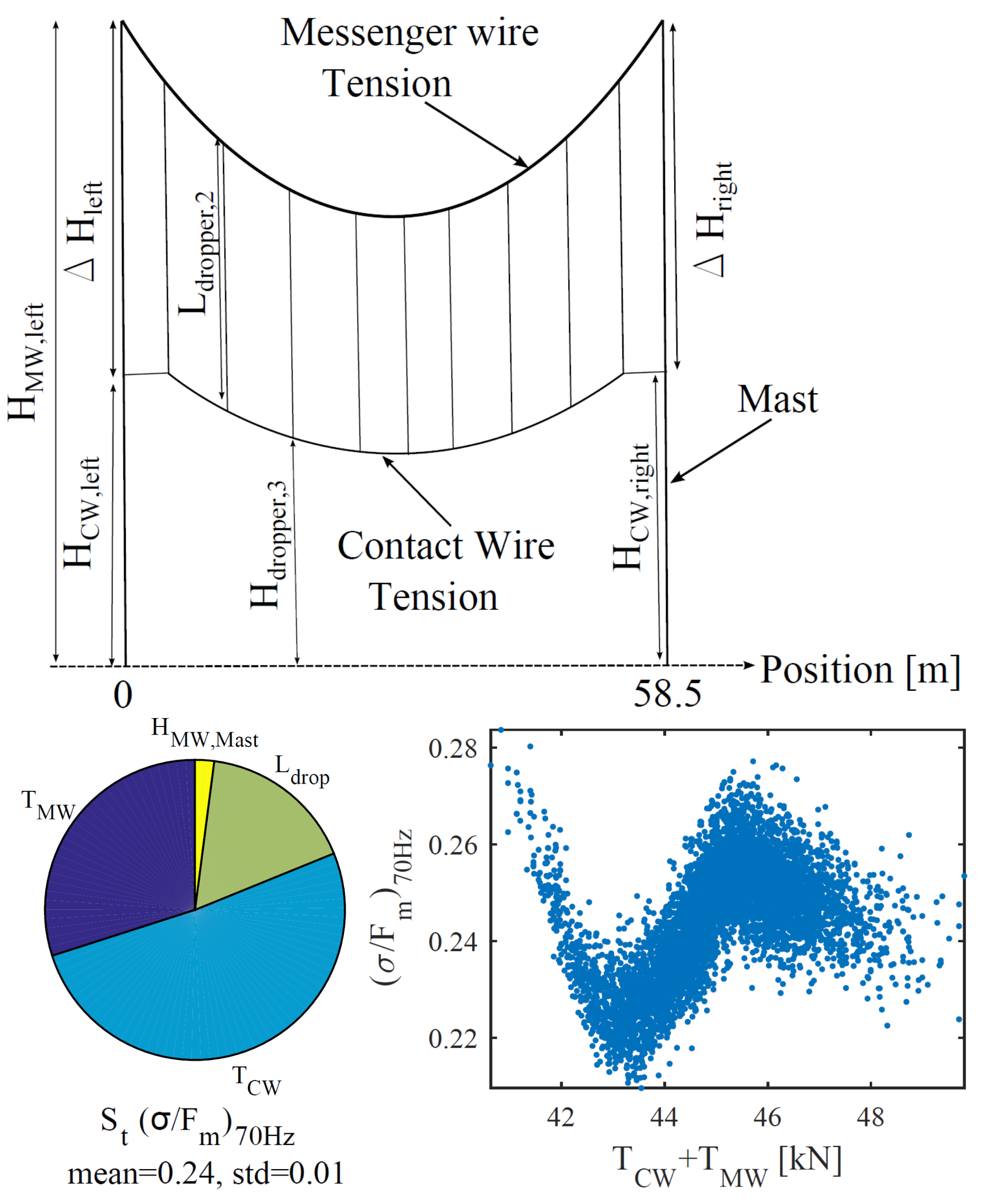 | Sensitivity analysis of catenary geometry on current collection quality O. Vo Van, E. Balmes, A. Capitaine, X. Lorang Railways 2016 Abstract[...]A global sensitivity analysis is led on catenary parameters such as dropper lengths, height of the messenger wire at masts and mechanical tensions in the wires thanks to the Sobol indices. All parameters are defined using experimental measurements. A set of geometric and dynamic criteria is selected as output and the contribution of theinput parameters to the output variability is quantified. It is shown that the dynamicinteraction is mainly sensitive to the mechanical tensions in contact and messenger wires whereas existing geometric criteria are mainly dependent on height of messenger wire at masts. Moreover, selected geometric criteria available using geometry measurements are hardly correlated with dynamic criteria. | #panto #conference | Download |
 | Introduction of variability into pantograph-catenary dynamic simulations O. Vo Van PhD Thesis 2016 Abstract[...]In railways, electrical current is generally collected by the train through a complex coupledmechanical system composed of a pantograph and a catenary. Dynamic phenomena that occur duringtheir interaction are still not fully understood. Furthermore, the system behaviour is sensitive to numerousparameters and thus highly variable. The first contribution of this thesis is a detailed analysis of thepantograph-catenary dynamic interaction separating phenomena due to the dynamic response of the pantographto the catenary geometry from wave propagations, reflections and transmissions that occur in thecatenary. The coincidence of frequencies or characteristic times is then shown to explain most variationsin the quantities of interest. Moreover, droppers surrounding the mast have been shown to be particularlyimportant in dynamic interaction. Ratio of wire impedances and sum of wave velocities also appeared tobe dimensioning quantities for catenary design. The second contribution was to reduce epistemic uncertaintylinked with model parameters such as catenary damping, contact stiffness and element size. Thefinal contribution was to use the model in a configuration with random parameters. An initial step was tostatistically characterise physical catenary parameters using available measurements. From this randommodel, ranking of uncertainties using Sobol indices on static and dynamic criteria was shown to be possible.An absence of correlation between geometric and dynamic criteria was also found, which has notableimplications for maintenance policies. The high number of sensitivity studies also gave the occasion tohighlight the maturity of simulation tool and propose directions for further work on design, maintenance orcertification of pantographs and catenaries. | #panto #thesis | Download |
 | Use of FEM models to study fatigue of overhead contact wires J.P. Massat, E. Balmes, J-P. Bianchi Railways 2016 Abstract[...]Fatigue cracks can induce fracture of the catenary Contact Wire (CW) and thus huge costs for the operator. Nowadays the wear criterion to replace the CW leads to lifespan over than 50 years, and the catenary can see a very high number of cycles so that fatigue life must be taken into account. A full process to compute the multiaxial transient stress field in the CW has been developed. A fatigue criticality indicator to assess the risk of crack initiation was introduced. This elaborate indicator is used to validate a simplified fatigue indicator based on the uniaxial Euler-Bernoulli beam stresses that are much faster to compute. This indicator is then used to assess parameters influencing the risk of fatigue in the case of junction claws. | #panto #conference | Download |
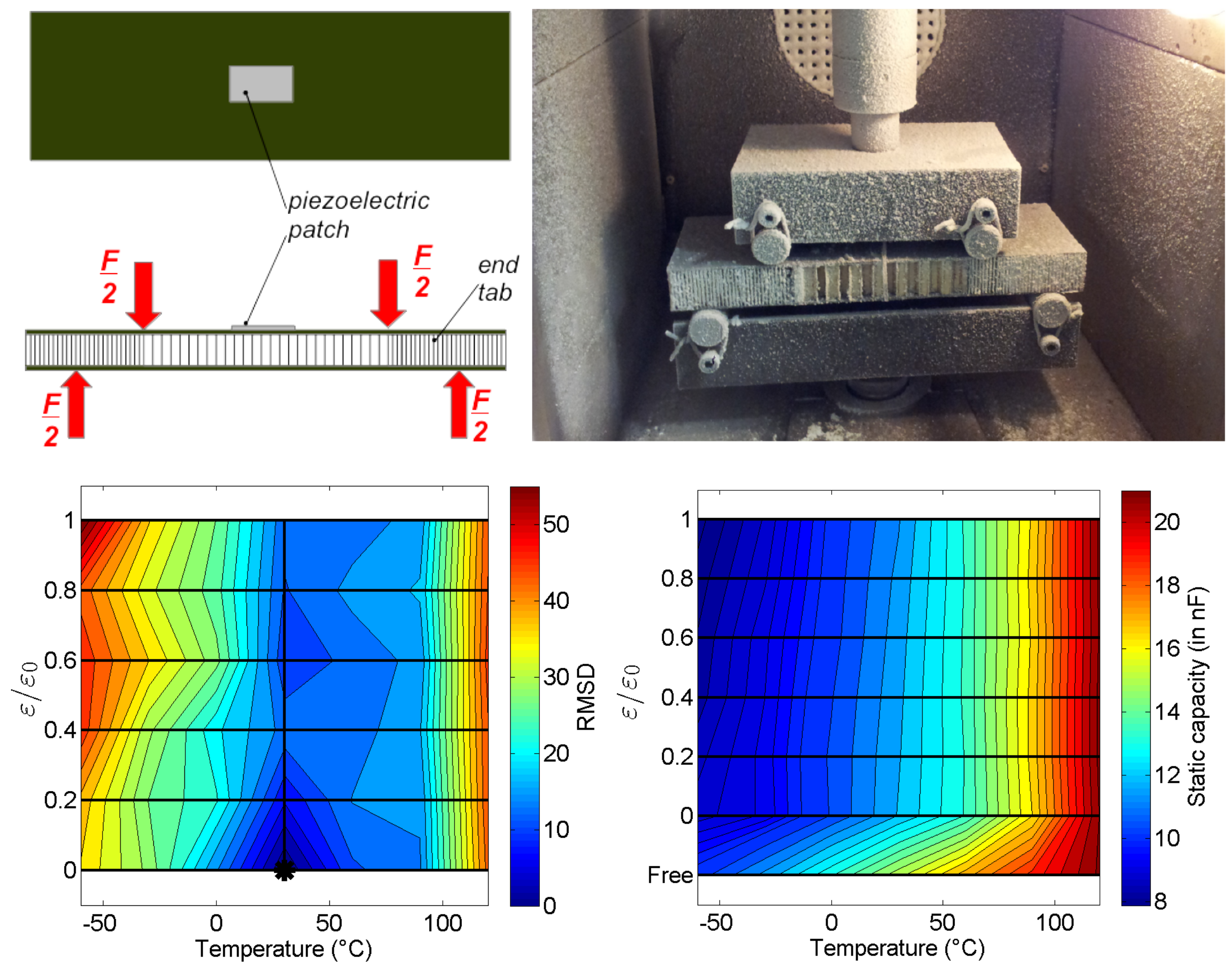 | Simultaneous Influence of Static Load and Temperature on the Electromechanical Signature of Piezoelectric Elements Bonded to Composite Aeronautic Structures M. Rebillat, M. Guskov, E. Balmes, N. Mechbal JVA 2016 Abstract[...]Electromechanical (EM) signature techniques have raised a huge interest in the structural health-monitoring community. These methods aim at assessing structural damages and sensors degradation by analyzing the EM responses of piezoelectric components bonded to aeronautic structures. These structures are subjected simultaneously to static loads and temperature variations that affect the metrics commonly used for damage detection and sensor diagnostics. However, the effects of load and temperature on these metrics have mostly been addressed separately. This paper presents experimentations conducted to investigate the simultaneous influence of static load and temperature on these metrics for two kinds of piezoelectric elements (lead zirconate titanate (PZT) and macrofiber composite (MFC)) bonded on sandwich composite materials, for the full range of real-life conditions encountered in aeronautics. Results obtained indicate that both factors affect the metrics in a coupled manner in particular due to the variations of the mechanical properties of the bonding layer when crossing its glass transition temperature. Furthermore, both piezoelectric elements globally behave similarly when subjected to temperature variations and static loads. Simultaneous accounting of both temperature and static load is thus needed in practice in order to design reliable structural health-monitoring systems based on these metrics. | #piezo #journal | Download |
 | Validation and verification of FE models of piezo based SHM systems. E. Balmes, M. Guskov, M. Rebillat, J.-P. Bianchi ISMA 2016 Abstract[...]The idea of generating and sensing Lamb waves through piezoelectric sensor/actuator configurations is common for Structural Health Monitoring (SHM) applications. Methods using time of flight analysis require the prediction of the first incoming waves. Computations on small periodic patterns are shown to be usable to determine which waves will actually be relevant. For the considered applications, these are the first membrane waves propagating at fairly high speeds. Parametric FEM computations are then used to analyze important parameters (mesh size, time step, damping) and it is shown that accurate predictions can be obtained in a few CPU minutes. | #piezo #conference | Download |
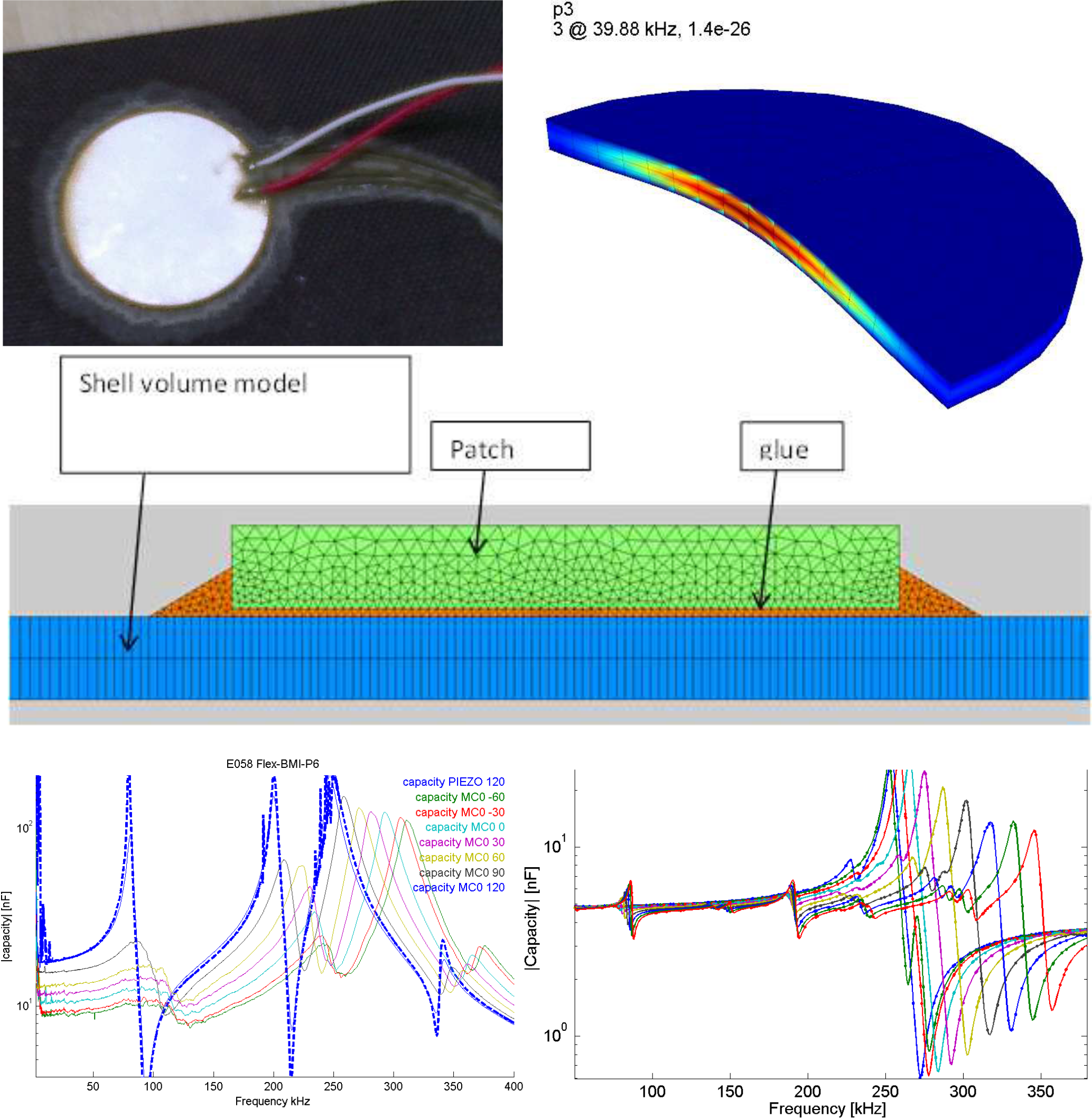 | Effects of temperature on the impedance of piezoelectric actuators used for SHM E. Balmes, M. Guskov, M. Rebillat, N. Mechbal VISHNO 2016 Abstract[...]- FEM modeling of piezoelectric patches used as actuators and sensors for SHM applications.- Test/analysis correlation of temperature effects in piezoelectric materials and glue - Numerical methods associated with the prediction of electric transfers. | #piezo #conference | Download |
 | Reduced dynamic models of piecewise periodic media : application to railway tracks. E. Arlaud PhD Thesis 2016 Abstract[...]Railway tracks have evolved over years based on empirical results and their dynamic behavior still can be difficult to assess or to quantify. A numerical model can thus provide assistance in track design by assessing the mechanical performance of new structures, or allowing the diagnostic of existing track parts, as a complement to relevant in-situ measurements.The numerical model developed in this work combines a reduction strategy with numerical techniques used to solve the propagation equations in waveguides in the frequency / wave number domains. The peculiarity of the exposed methodology is the introduction of a model based on a periodic sub structuring of the track, keeping only a few wavelengths carefully chosen to solve dispersion equations. Based on this model reduction technique and its extension to time domain models with moving contact, the computational time and storage capacity required are greatly reduced. Thus, this model is efficient and useful for engineering purposes in railway tracks studies.Numerical validation of the reduction is carried out by building a complete reference model in the frequency domain. In parallel, measurement campaigns (receptance measurement and sleeper acceleration under passing trains) were performed on a transition zone between ballasted and slab tracks on a High Speed Line. These tests are compared to simulation results in both time and frequency domains on different areas of the transition. After successful validation, the model is used to improve understanding of the role of the substructure on the dynamic behavior.The final major development of this work is the introduction of a strategy to extend the reduction to piecewise periodic structures and the development of post-processing tools to highlight the dynamic effects generated by the transition zone. | #rail #reduction #thesis | Download |
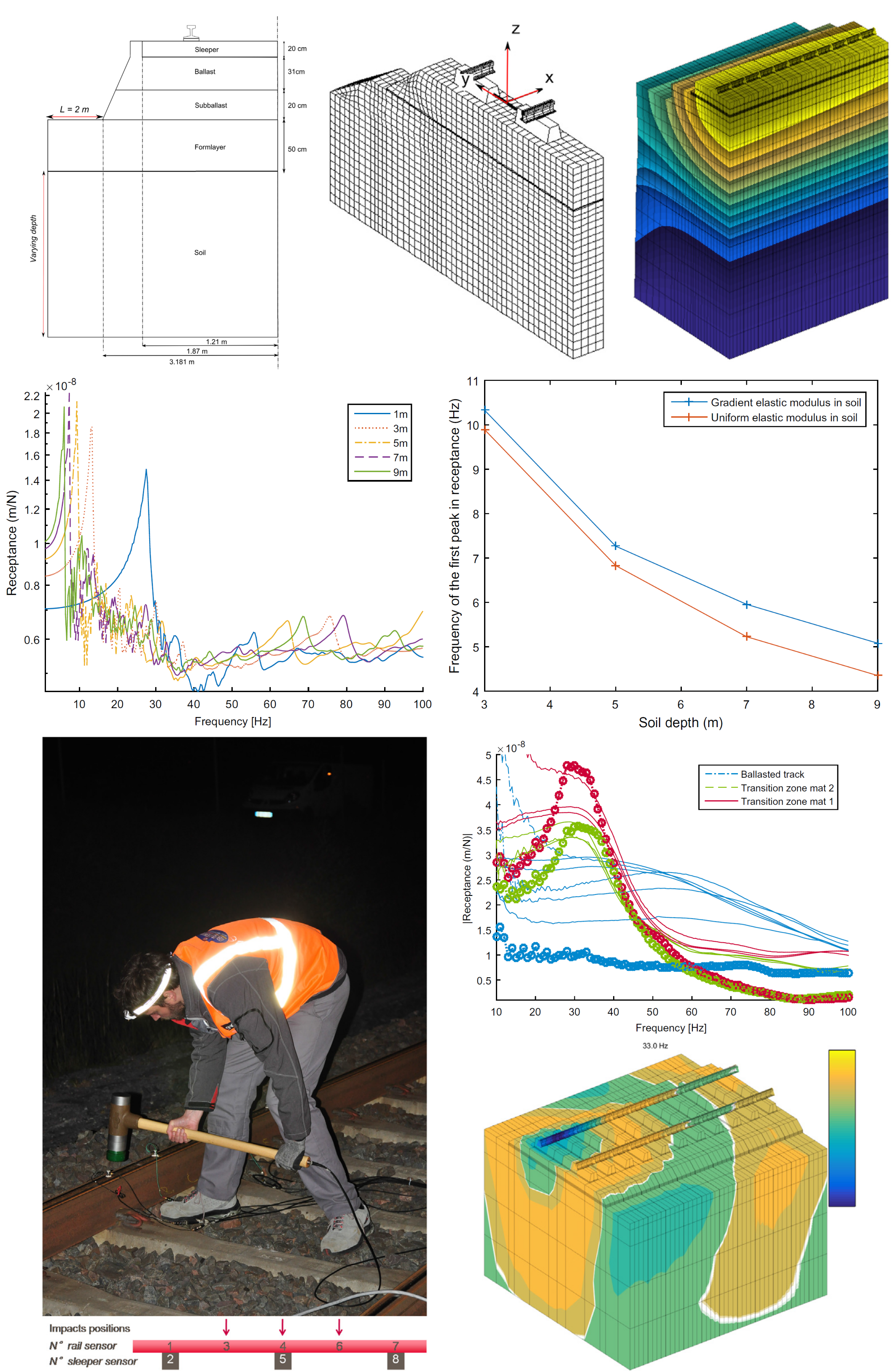 | Receptance of railway tracks at low frequency: Numerical and experimental approaches E. Arlaud , S. Costa d'Aguiar, E. Balmes Transportation Geotechnics 2016 Abstract[...]This paper presents numerical simulations and experimental studies on the frequency domain behavior of railway track below 100 Hz, focusing on the link between the substructure properties of the track and its global dynamic response. A numerical method in the frequency domain is first proposed and used to understand the frequency response of a railway track with a French High Speed Line (HSL) design. Then, low-frequency receptance measurements, performed in a specific HSL test site with different designs, are presented. These experimental results are used to characterize a change in the track substructure. Further analysis of the full track responses associated with peaks visible in the receptance test is conducted using numerical simulations. In the considered test case, these simulations demonstrate the existence of the superstructure and ballast resonance on relatively soft mats. | #rail #reduction #journal | Download |
 | Numerical design and test on an assembled structure of a bolted joint with viscoelastic damping C. Hammami, E. Balmes, M. Guskov MSSP 2015 Abstract[...]Mechanical assemblies are subjected to many dynamic loads and modifications are often needed to achieve acceptable vibration levels. While modifications on mass and stiffness are well mastered, damping modifications are still considered difficult to design. The paper presents a case study on the design of a bolted connection containing a viscoelastic damping layer. The notion of junction coupling level is introduced to ensure that sufficient energy is present in the joints to allow damping. Static performance is then addressed and it is shown that localization of metallic contact can be used to meet objectives, while allowing the presence of viscoelastic materials. Numerical prediction of damping then illustrates difficulties in optimizing for robustness. Modal test results of three configurations of an assembled structure, inspired by aeronautic fuselages, are then compared to analyze the performance of the design. While validity of the approach is confirmed, the effect of geometric imperfections is shown and stresses the need for robust design. | #damping #journal | Download |
 | Review of model updating processes used for brake components G. Martin, E. Balmes, G. Vermot des Roches, T. Chancelier Eurobrake 2015 Abstract[...]To be confident in the prediction capability of a model, verification and validation steps are classically performed. Verification checks that the model is properly solved. Since the model used are fairly standard, this is not issue for brake components. Validation checks the relation between model and experiments on actual structures. Here geometry measurements and vibration tests are considered. The study seeks to perform a systematic review of how test quality is evaluated, and models are correlated and then updated. This will give a solid basis to define clear and easily used validations protocols for brake components where prediction of modes and their stability in the manufacturing process is often deemed critical. Updating the geometry before updating the material properties is shown to be very important: the residual error on frequencies is smaller and no bias is introduced in the estimated material properties. Proper pairing of modeshapes is important for broadband comparisons and the MAC criterion is used. Intermediate steps: experimental topology correlation using easy tools with accuracy evaluation, estimation of errors on test shapes, handling of mode crossing, are sources of errors that are analyzed. For the updating of contact properties, where many parameters may need update, the use of model reduction is shown to allow a major speed-up of parametric studies. | #HybridTwin #conference #brake | Download |
 | OSCAR Statement of Methods J.P. Massat, E. Balmes, J.P. Bianchi, Van Kalsbeck, G, VSD 2015 Abstract[...]OSCAR (Outil de Simulation du CAptage pour la Reconnaissance des défauts) is the pantograph–catenary dynamic software developed by Société Nationale des Chemins de fer Français (SNCF) since 2004. A three-dimensional finite element (FE) mesh allows the modelling of any catenary type: alternating current (AC) or direct current (DC) designs, and conventional or high-speed lines. It is a representative of the real overhead line geometry, with contact wire (CW) irregularities, staggered alignment of the CW, dropper spacing, wire tension, etc. Nonlinearities, such as slackening of droppers and unilateral contact between the pantograph and the CW, are taken into account. Several pantograph models can be used, with a complexity level growing from the three-lumped-mass model to the multibody model. In the second case, a cosimulation between the FE method catenary and the multibody pantograph models has been developed. Industrial features for pre- and post-treatments were developed to increase robustness of results and optimise computation time. Recent developments include volume meshing of the CW for stress computation or statistical analysis and lead to new fields of studies such as fatigue failure or design optimisation. OSCAR was fully validated against in-line measurements for its different AC and DC catenary models as well as its different pantograph models (with independent strips for instance) and has continuously been certified against EN50318 since 2008. | #panto #journal | Download |
 | Dynamic stress prediction in catenary wires for fatigue analysis J.P. Bianchi, E. Balmes, Nguyen-Tajan M.L, IAVSD 2015 Abstract[...]Fatigue cracks in the contact wire are a possible cause of fracture which can induce huge costs. Fatigue study is thus of a great interest but requires an accurate computations of stress distributions. OSCAR is a SNCF software used to study coupled pantograph / catenary dynamics. It is based on Euler-Bernoulli beam meshes. This formalism is accurate to study the catenary displacements, but is not sufficient to compute multi-axial stresses, in particular in parts that can concentrate stresses such as the junction claws. This paper details and illustrates the strategy developed to compute a full multi-axial transient stress field, in any point of the contact wire. The dynamic displacement computed by OSCAR is expanded and combined with a precise nonlinear static state of a mixed model of beams and volume elements. | #panto #conference | Download |
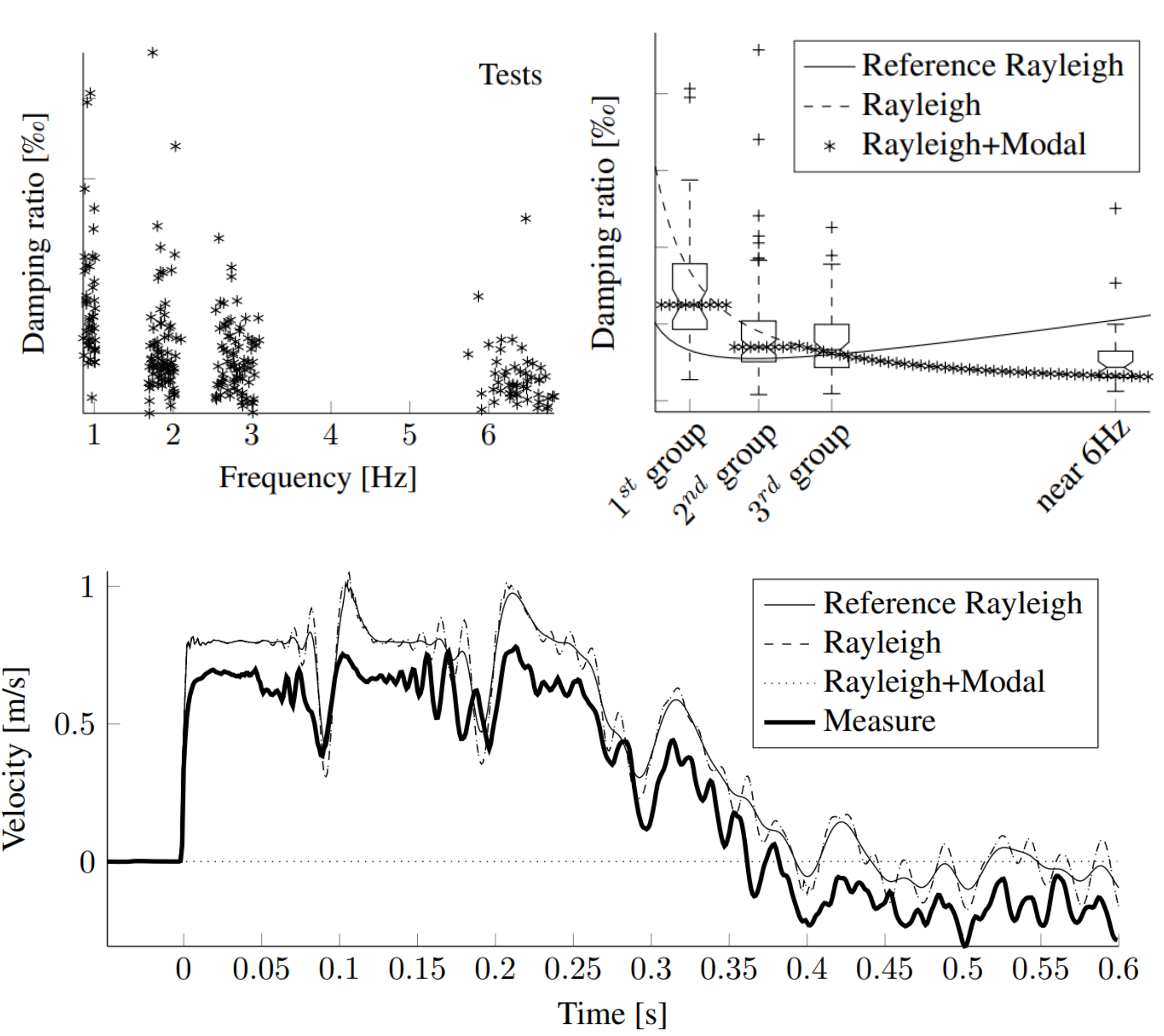 | Damping characterization of a high speed train catenary O. Vo Van, E. Balmes, X. Lorang IAVSD 2015 Abstract[...]Catenary damping has long been a tuning parameter in pantograph-catenary dynamic interaction models. As the computed contact force is highly sensitive to the choice of damping model or coefficients, it became critical to measure it independently of the pantograph. Original tests have been conducted on a real catenary and damping identification shows a very low level of damping for a large frequency range. A fitted Rayleigh model and a combined modal and Rayleigh model are proposed and compared with a reference damping model found in literature as well as with the tests. Finally, the consequences on a typical contact force simulation are analysed and the most relevant model is chosen. | #panto #conference | Download |
 | Squeal Complex Eigenvalue Analysis, Advanced Damping Models and Error Control G. Vermot des Roches, O. Chiello, E. Balmes, X. Lorang Eurobrake 2015 Abstract[...]Estimation of brake systems stability related to noise emission is part of the industry state-of-the-art for brake design. Improved assessment of stability would allow better NVH performance from early design stages thus reducing costs related to late redesign and testing. The prediction capability however remains challenged due to the complexity of brake noise phenomena. In particular, integration and resolution of complex systems with damping is a difficult task that is commonly overlooked. This paper proposes two ideas to improve stability estimation. From the solver side, a convergence indicator is proposed to quantify the convergence of the complex eigenvalues for subspace based methods. The error obtained can be directly used to enhance the computation subspace and a priori enhancement is suggested. From the modelling side, a damping strategy based on sub-assembly modal damping ratios is proposed allowing direct exploitation of test measurements or refined sub-assembly simulations for damping estimation. Sub-assembly damping can thus be accounted for at the system level including all possible effects like joint dissipation or composite materials. | #brake #conference | Download |
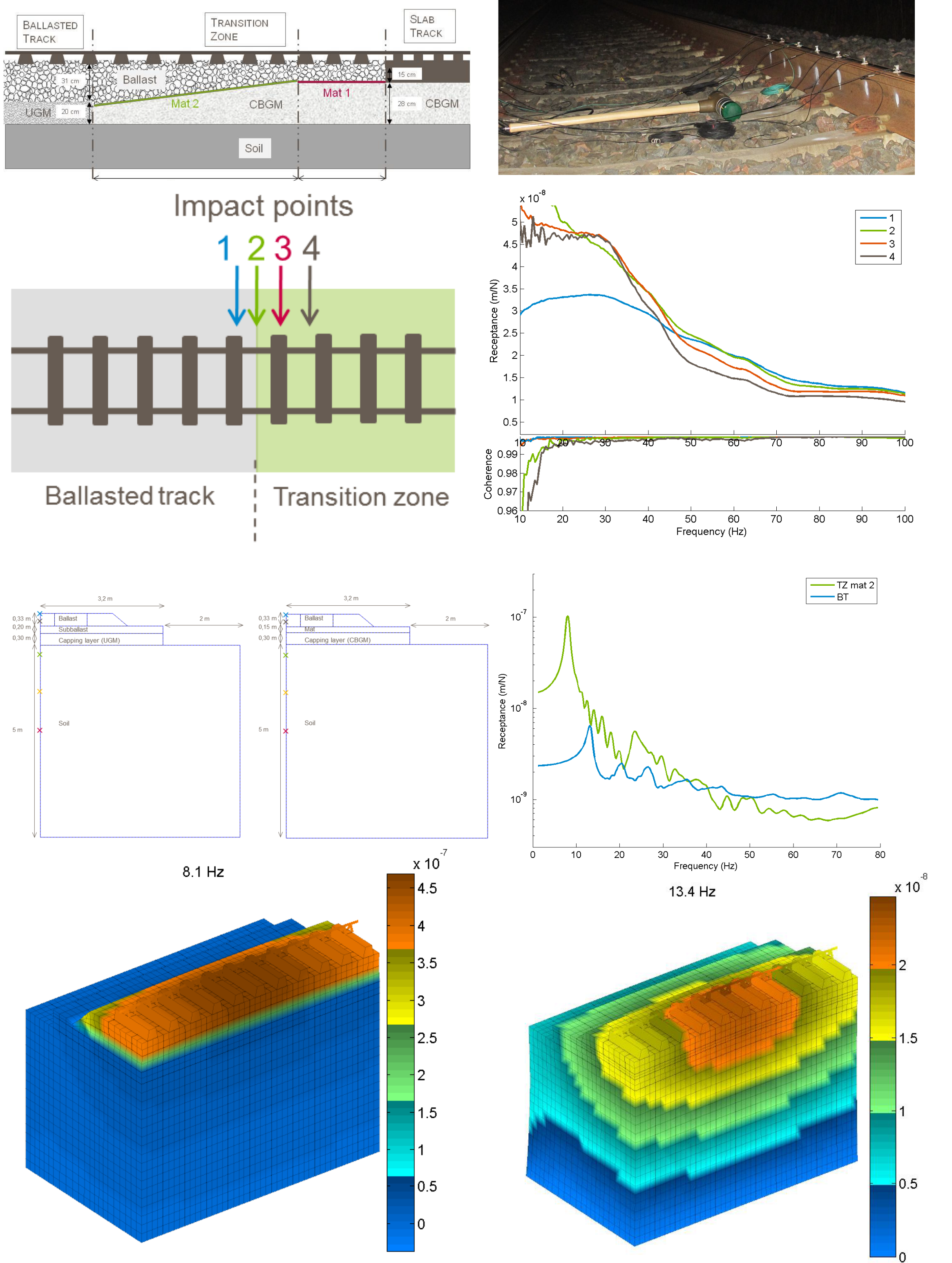 | A numerical tool to assess the dynamic behaviour of different track designs E. Arlaud, S. Costa D'Aguiar, E. Balmes Railway Engineering 2015 Abstract[...]Receptance tests are widely used, in-situ, to get information experimentally on the global dynamic behaviour of tracks. As a complement to this measurement, numerical models can be of great use to the diagnose of existing tracks, especially in zones presenting unexpected response to passing trains or in zones with specific design, providing a more detailed mechanical response. The Dynavoie software used in this paper is a finite element model which aims at offering a comprehensive view of the global track response, taking into account both track and platform. In the developed approach, all the components of the system, from the rail to the soil are of interest. This global approach combined with the low computation time due to the reduction strategy is specificity of the software. This paper presents an experimental and numerical work on receptance tests. Receptance test measurements carried on an existing track are first presented. Then, the same track is analysed in the frequency domain using the numerical model described above. Finally, the model is used to understand the link between the frequency behaviour of the track and its dynamic behaviour to moving load in the time domain. | #rail #reduction #conference | Download |
 | Meta-models of repeated dissipative joints for damping design phase C. Hammami, E. Balmes ISMA 2014 Abstract[...]Developing tools to predict dissipation in mechanical assemblies starting from the design process is a subject of increasing interest. Design phases imply numerous computations resulting from the use of families of models with varying properties. Model reduction is thus a critical tool to make such design studies affordable. Existing model reduction methods make computation of models with detailed non-linear parts accessible although costly although allowing the generation of a small size model for the linear part. One is, thus, interested in introducing meta-models of the behavior in the non-linear part by determining a basis of principal joint deformations. In this work, one seeks to validate the ability to predict macro-forces associated with the principal deformation shapes. Taking the case of aeronautic structures as cylindrical ones with multiple joints, one seeks to validate the construction of a meta-model associated to the joint. The ability to use such a meta-model to predict damping associated with viscoelastic behavior in a specifically designed bolted joint will be illustrated. | #damping #conference | Download |
 | The Component Mode Tuning (CMT) method. A strategy adapted to the design of assemblies applied to industrial brake squeal. G. Vermot des Roches, G. Rejdych, E. Balmes, T. Chancelier Eurobrake 2014 Abstract[...]Numerical prototyping is widely used in industrial design processes, allowing optimization and limiting validation costs through experimental testing. Industrial applications nowadays focus on the simulation of complex component assemblies that are generally mass produced. Coupling properties thus have to be modelled, updated and accounted for variability. For squeal applications, simulations still fail at robustly producing exploitable results due to the systems complexity, while experimentations are limited for diagnostic and design improvement. This paper presents a new application of the Component Mode Tuning, an efficient model reduction method adapted to quick system level reanalysis as function of component free modes, to study the effect of coupling. The impact of component coupling stiffness and coupling surface topology is thus assessed on a drum brake subassembly which design is sensitive to squeal. It is shown that significant system differences can come from coupling surface variations with patterns close to experimental observations. This emphases the need for refined analyses to control coupling in the perspective of robust modelling. | #reduction #brake #conference | Download |
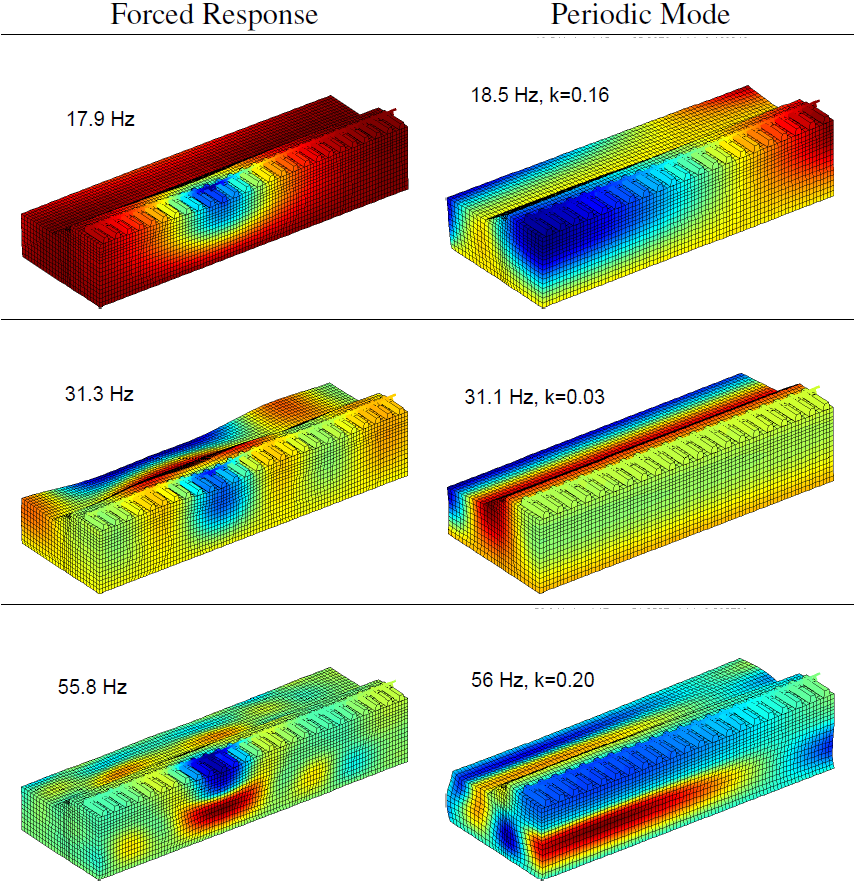 | Validation of a reduced model of railway track allowing long 3D dynamic calculation of train-track interaction E. Arlaud, S. Costa d'Aghuiar, E. Balmes IACMAG 2014 Abstract[...]In order to face challenges of increased traffic and speed on their infrastructures, railway companies need to develop numerical tools able to predict the dynamic behaviour of the track. Currently, two approaches are widely used: the first one is a train-based methodology in which train dynamic is well reproduced but track is only represented as equivalent springs, the second one is a FEM model or FEM/BEM model of track in which the train is simply modeled as a moving load but the complexity of track taken into account. Dynavoie software studied in this work aims to offer a new approach by representing in details both track and train. Understanding train-track interaction requires transients on long track segments, leading to very large finite element models and high computation time. The specificity of Dynavoie software is to use periodic properties of the track to generate a reduced slice model, and then build the track as a combination of these slices. Computation time is then highly reduced. The present work focuses on the initial step of the model reduction where computations in the frequency and wave domains are used. The resulting 3D periodic computations are compared to 2.5D FEM/BEM results from the literature and the content of the receptance curve is discussed in relation with dispersion curves. | #reduction #conference #rail | Download |
 | Statistical identification of geometric parameters for high speed train catenary O. Vo Van, E. Balmes, J.P. Massat ISMA 2014 Abstract[...]Pantograph/catenary interaction is known to be strongly dependent on the static geometry of the catenary, this research thus seeks to build a statistical model of this geometry. Sensitivity analyses provide a selection of relevant parameters affecting the geometry. After correction for the dynamic nature of the measurement, provide a database of measurements. One then seeks to solve the statistical inverse problem using the maximum entropy principle and the maximum likelihood method. Two methods of multivariate density estimations are presented, the Gaussian kernel density estimation method and the Gaussian parametric method. The results provide statistical information on the significant parameters and show that the messenger wire tension of the catenary hides sources of variability that are not yet taken into account in the model. | #panto #conference | Download |
 | Pantograph catenary dynamic optimisation based on advanced multibody and finite element co-simulation tools J.P. Massat, C. Laurent, J.P. Bianchi, E. Balmes VSD 2014 Abstract[...]This paper presents recent developments undertaken by SNCF Innovation & Research Department on numerical modelling of pantograph catenary interaction. It aims at describing an efficient co-simulation process between Finite Element (FE) and Multibody (MB) modelling methods. FE catenary models are coupled with a full flexible MB representation with pneumatic actuation of pantograph. These advanced functionalities allow new kind of numerical analyses such as dynamic improvements based on innovative pneumatic suspensions or assessment of crash risks crossing areas that demonstrate the powerful capabilities of this computing approach. | #panto #journal | Download |
 | Understanding friction induced damping in bolted assemblies through explicit transient simulation. G. Vermot des Roches, E. Balmes ISMA 2014 Abstract[...]The design of joints is seeing increased interest as one of the ways of controlling damping levels in lighter and more flexible aeronautic structures. Damping induced by joint dissipation has been studied for more than a decade, mostly experimentally due to the difficulty of simulating large structures with non-linearities. Experimentally fitted meta-models were thus used for damping estimation at design stage without a possible optimization. The aim of this paper is to demonstrate that damping estimation using local friction models is feasible and that it can be usable for design. The simulation methodology is based on an explicit Newmark time scheme with model reduction and numerical damping that can be compensated for the modes of interest. Practical simulation times counted in minutes are achieved for detailed models. The illustration on a lap-joint shows how simulations can be used to predict the amplitude dependence of modal damping, answer long standing questions such as "does the modeshape change?" or analyze the evolution of pressure fields during a cycle. | #brake #conference | Download |
 | Integration of dissipative joints models in the vibratory design of damped structure C. Hammami PhD Thesis 2014 Abstract[...]Dissipation in mechanical systems plays an important role in limiting vibrationlevels. The present work deals with maximizing damping induced by junctions and treatsjunctions integrated into an overall structure. After introducing the physical models used inrepresenting viscoelastic behavior, a first example introduces the concept of coupling. Coupling,estimated by preliminary calculations of elastic natural frequencies sensitivity, ensures thatjunctions sufficiently contribute to the global behavior to induce damping. To study this couplingas well as obtain accurate damping predictions by complex modes calculation, model reductionmethods, adapted to parameterized problems, are needed and different strategies are detailedand validated. A structure representing aeronautic construction is then used to illustrate theproposed damping design process. The study highlights the functional importance of thecohesive zone under the bolt and the possibility of using the residual flexibility of the joint tointroduce a viscoelastic layer enabling high damping. Experimental modal tests confirm thevalidity of the design and the predicted trends, but also show the influence of manufacturingdefects which limit the induced damping. The manuscript finally addresses the need forrepresentative models of detailed joints in overall models. Although model reduction is possibleand desirable, the construction of meta-models representing the main forces transmitted by thejoints is useful in modeling and necessary for the operation of elementary tests. Generalstrategies for defining principal deformations and loads are introduced and their validity isillustrated. | #damping #thesis | Download |
 | Improved Modal Assurance Criterion using a quantification of identification errors per mode/sensor G. Martin, E. Balmes, T. Chancelier Eurobrake 2014 Abstract[...]Scanning laser vibrometer measurements generate detailed maps of modal characteristics in normal or 3D directions. Since many points are measured, individual validation of cannot be performed manually in a reasonable time frame and a notable fraction of measurements is expected to be fairly noisy. The key new notion of the paper is a quantification of identification error and level of contribution for each mode and each sensor based on the comparison of measured and synthesized transfers around each resonance. These criteria are shown to allow efficient analysis of the validity of large measurement sets to provide an automated procedure to select sensors that should be kept for each mode. This quantification, being performed before correlation, provides a priori estimates of sources of poor correlation associated with the identification process. It thus becomes possible to provide improved Modal Assurance Criterion estimations where, for each modeshape, sensors known to be incorrectly identified can be discarded. The 3D vibrometer scan of a brake component is used to illustrate the proposed strategies. | #brake #HybridTwin #conference | Download |
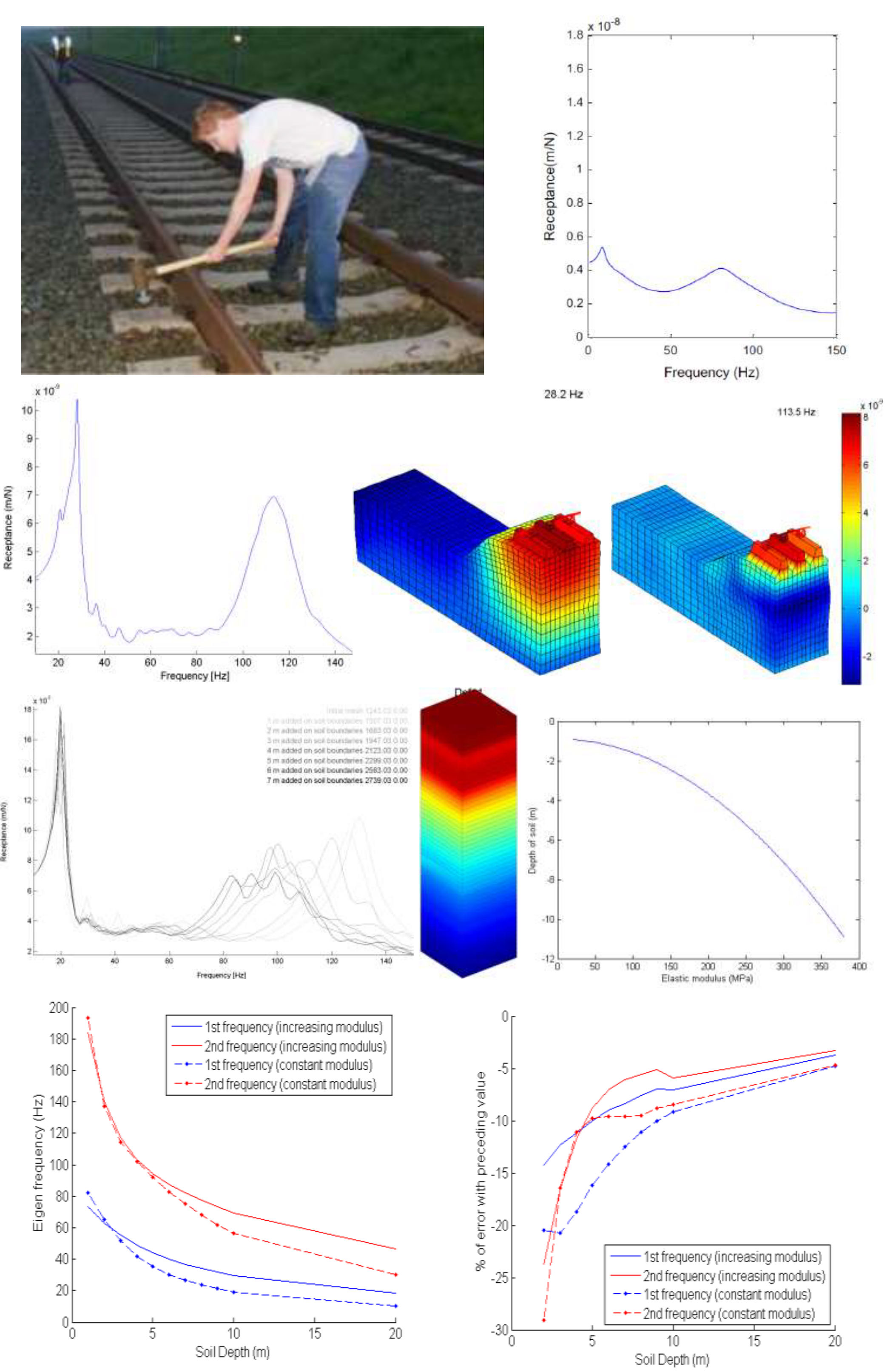 | A reduced track model to understand the dynamic behavior of the track E. Arlaud, S. Costa d'Aguiar, E. Balmes GEORAIL 2014 Abstract[...]Nowadays, trends in railways are for more traffic at higher speed, whereas infrastructures remain basically unchanged. As track design has evolved over the years based on experience, the introduction of numerical models could be a tool to gain better understanding of track behaviour and improve track design. Dynavoie software is a finite element model which aims to offer a comprehensive view of the track, taking into account all the components of the system, from the rail to the soil. This global approach is a specificity of the software, as well as the low computation time due to the reduction strategy. This paper presents model validation steps in the frequency domain, computing a receptance test and comparing it to another model presented in the literature. A characterisation of the railway substructure based on this test is then proposed. | #rail #reduction #conference | Download |
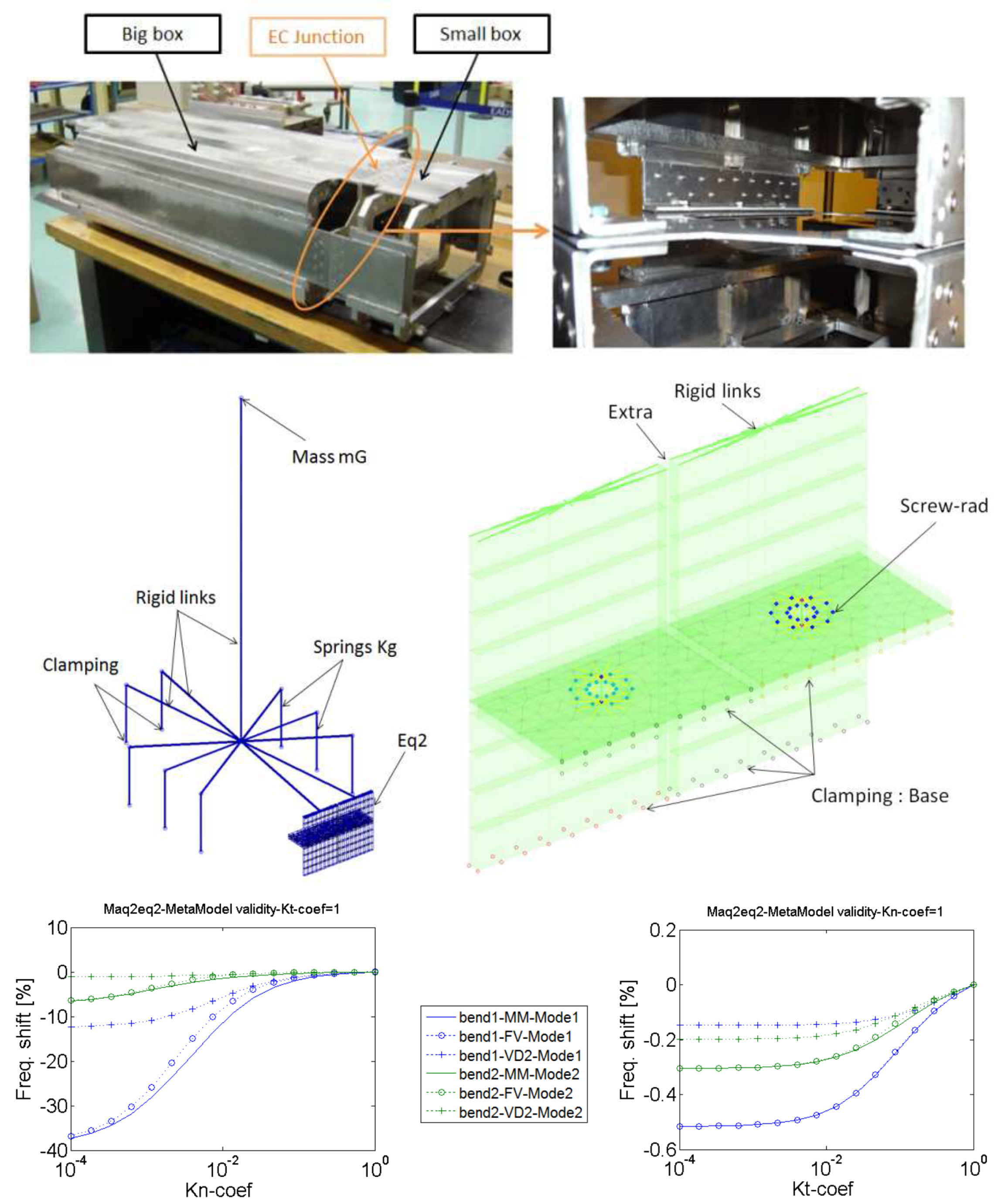 | Reduced joint models for damping design of multi-jointed structures C. Hammami, E. Balmes, M. Guskov VISHNO 2014 Abstract[...]− Design of damping in multi-jointed structures is studied here.− Dissipation sources are viscoelastic behavior and contact/friction at joints interfaces. − Reduction on meta-models of nonlinear joints models is investigated. − Experimental characterization of nonlinear forces. | #damping #reduction #conference | Download |
 | Squeal noise of railway disc brakes: correlation between experiments and transient computations from updated simplified pad models O. Chiello, J.-J. Sinou, N. Vincent, G. Vermot Des Roches, F. Cocheteux, S. Bellaj, X. Lorang The Journal of the Acoustical Society 2013 Abstract[...]The squeal noise generated by railway disk brakes is an everyday source of discomfort for the passengers both inside and outside the trains in stations. The development of silent brake components is needed and requires a better characterization and understanding of the phenomenon. This is the aim of the experimental and numerical investigations performed in the framework of the French AcouFren project and presented in this paper. The first part is concerned with the analysis of experimental data coming from bench tests in a lot of braking configurations including different brake pads. In the second part, the measurements are compared with the results of a large FE model of the brake taking into account the mechanical complexity of each component, especially the brake pads. Components models have been previously updated using experimental modal analysis but the whole model is a direct assembling of it, without updating. The assumption of unilateral contact and Coulomb friction at the pad/disc interface is sufficient to destabilize the sliding equilibrium of the brake and lead to self-sustained vibrations. Complex vibrating modes are computed in order to describe and understand the dynamic instabilities. | #brake #conference | Download |
 | Frequency and time simulation of squeal instabilities. Application to the design of industrial automotive brakes. G. Vermot des Roches PhD thesis 2011 Abstract[...]Brake squeal is a common noise problem encountered in the automotive industry. Higherfriction coefficients and weight reduction recently led to higher vibration levels in the audiblefrequency range. This quality issue becomes economic due to penalties imposed to the brakesupplier although no robust design method exists. The industrial practice thus relies on costlyprototyping and adjustment phases. The evolution of computational power allows computationof large mechanical assemblies, but non-linear time simulations generally remain out of reach.In this context, the thesis objective is to provide numerical tools for squeal resolution at earlydesign stages.Parameterized reduction methods are developed, using system real modes as Rayleigh-Ritzvectors, and allow very compact reduced models with exact real modes. The proposed ComponentMode Tuning method uses the components free/free modes as explicit degrees of freedom.This allows very quick sensitivity computation and reanalyzes of an assembly as function oflocal component-wise parameters. Non-linear time simulations are made possible through twoingredients. A modified non-linear implicit Newmark scheme and a fixed Jacobian are adaptedfor contact vibrations. The brake is reduced keeping a superelement with exact real modes anda local non-linear finite element model in the vicinity of the pad/disc interaction.A set of design tools is illustrated for a full industrial brake model. First, instant stabilitycomputations and complex mode trajectories are studied. Modal interactions and non-linearphenomena inside the limit cycles are thus well understood. Time/frequency correlations areperformed using transient modal identification and space-time decomposition. A time domainmodal damping model is also shown to be very useful. The modification of a critical componentfor squeal resolution is finally tested and validated. | #brake #reduction #thesis | Download |
 | Study of a nonlinear system with shocks under broadband excitation : application to a steam generator tube T. Thenint PhD Thesis 2011 Abstract[...]The steam generator is a heat exchanger and participates to the nuclear safety. Energy is transferred from the primary to the secondary fluid through many U-tubes maintained vertically by support plates. A sludge deposit tends to modify the boundary conditions and the secondary fluid flow. A fluid-elastic instability can then occur and lead to quick tube ruin. This thesis seeks a better understanding of the effect of contact nonlinearity on the dynamics of a tube in-air intermittently impacting the support plates and its consequences in regards with instability. The use of discretized contact conditions with circular obstacles distributed over the thickness of the plates and the use of enriched reduction bases allow quick and relevant nonlinear numerical simulations. These simulations are well correlated with experimental measurements and valid even with strong nonlinearity or negative modal damping. The evolution of power spectral densities (PSD) with growing excitation amplitude is analyzed: padding of the anti-resonances, peak shift and spread. It is then shown that an apparent stiffness associated with a permanent bilateral contact is pertinent to describe these transitions. In the case of an unstable linear system, one demonstrates that the nonlinearity keeps the responses bounded or stabilised, thus paving the way for future work with real or simulated fluid flows. | #thesis | Download |
| Modeling of the viscoelastic honeycomb panel equipped with piezoelectric patches in view of vibroacoustic active control design C. Florens PhD Thesis 2010 Abstract[...]Active control has often been considered for low frequency control of noise radiated by trim panels inside aircraft or helicopter cabins. Trim panels are usually made of honeycomb core sandwich because of their high strength to mass ratio. Active control techniques applied to honeycomb panel have not always given results as good as expected and this thesis aims to understand these limitations based on validated mechanical models of the active panels. For the modeling of honeycomb panels, the main difficulty is to estimate equivalent properties for the core. A numerical homogenization procedure is introduced to estimate effective parameters of a shell/volume/shell model based on the correlation with periodic modes of a detailed 3D model. The use of periodic modes allows a detailed analysis of the influence of constituent properties, especially glue and skin. Tests show that the considered Nomex based honeycomb has significantly viscoelastic behavior. In the model, the viscoelastic behavior of the core is taken into account by a frequency dependence of material parameters. Piezoelectric actuators and sensors are included in the validated honeycomb model. Strategies for integration in a numerical design process are discussed. Finally, the static response to an applied voltage is shown to correspond to a blister shape with local bending of the skin rather than global bending of the panel. This behavior results in poor actuator performance, which is also found in a realistic panel configuration studied at ONERA. | #piezo #thesis | Download | |
 | Multi-level parametric reduced models of rotating bladed disk assemblies A. Sternchüss PhD Thesis 2009 Abstract[...]Bladed disks found in turbomachines are complex structures whose vibration characteristics are generally determined by exploiting the symmetry properties of their nominal configuration. This symmetry no longer exists either when disks are assembled to form a rotor or when discrepancies in the mechanical parameters are introduced (intentional or unintentional mistuning). Fine meshes required to correctly evaluate stress distributions would lead to prohibitive model sizes (typically a few million degrees of freedom). The objective of this thesis is to introduce model reduction techniques that rely on the combination of separate computations of acceptable size. This provides a means for in-depth studies of the behaviour of dense 3D models of multi-stage bladed rotors with possible mistuning. At first, Fourier transforms performed separately on each individual disk allows to understand the inter-harmonic coupling induced by inter-stage coupling and mistuning. From this study, a first method uses cyclically symmetric solutions plus sector modes with fixed inter-sector interfaces to build a reduced sector model. The latter is exact for target modes and very accurate for others. This method is extended to multi-stage assemblies by employing multi-stage mono-harmonic eigensolutions. Illustrations focus on the proposed methodology that enables to deal with large scale industrial models while remaining compatible with various post-processing procedures (free or forced response computations, analysis of their spatial harmonic content, energy distributions and localization effects...). This methodology is finally extended to the handling of parametric models depending on the rotation speed. The enrichment of the initial sets of target vectors with computations at three rotation speeds enables a fast and accurate recovery of the evolution of the eigenfrequencies with respect to the rotation speed in any operating range. | #thesis | Download |
| Extending structural dynamic modification methods to the design of viscoelastic damping devices B. Groult PhD Thesis 2008 Abstract[...]The aim of this work is to extend the use of a structural dynamic modification method to cases of damping device design. These devices are meant to improve the mechanical behaviour of some structures used by EDF (Electricité de France). The first step of the work is to give theoretical bases on the modelling of heavily damped structures and especially viscoelastic ones. One then performs a design study for an experimental testbed that is representative of structures EDF wants to treat. The performance of the damping device is evaluated experimentally and compared with the numerical results. This numerical design study highlights the limitations of classical design methods in the context of industrial exploitation of EDF (non updated models, complex structures, access to measurements limited). The second part of the work thus deals with the adaptation of a structural dynamic modification method to the case of the proposed damped modification. The chosen method is based on a modal coupling formulation that has been tested within EDF on undamped applications. But the method needs some adaptations because of the use of damping terms in equations and the fact that the mechanical behaviour is frequency dependant (a characteristic of viscoelastic materials). The robustness of the method is then analyzed through some points that are important for its application. The method is experimentally validated through the testbed. | #damping #HybridTwin #thesis | Download | |
 | Vibroacoustic measurement and prediction of viscoelastic structures. Application to an acoustic chamber G. Kergourlay PhD Thesis 2004 Abstract[...]Damping augmentation is a common approach to vibration control in structures (vibroacoustics, vibration fatigue). Viscoelastic materials can be used to design efficient damping treatments. The mechanical properties of these materials however depend on frequency, but also on prestress and temperature. Traditional representations for viscoelastic materials, finite element design and computation methods for damped structures are presented along with new reduction techniques such as the Residual Iteration process.A dynamic test bench has been designed and built to measure directly the complex stiffness of viscoelastic films of standard sandwich plates using an electrodynamic shaker in the frequency range of 1-2000 Hz, for temperatures of 0-50°C and what is new, for static shear rates of 0-300 %. The tests reveal how the temperature-frequency superposition hypothesis can be extended to prestress. The second objective of this work is to investigate and improve the vibroacoustic behaviour of an audio speaker. A finite/boundary element model is built and validated through measurements for the low frequency range (0-2000 Hz). An efficient damping treatment is proposed and its properties optimized. | #damping #thesis | Download |
 | Improvement of structural dynamic modification method using data expansion and model reduction techniques M. Corus PhD Thesis 2003 Abstract[...]This work deals with the improvements of methods devoted to estimate the influence of modifications on the dynamic behaviour of a structure (addition of stiffeners or masses, boundary condition changes). The input data for the method are an experimentally derived model of the initial structure and a numerical model of the modification. Based on a coarse model of the structure to be modified, the proposed methodology tackles two major difficulties : efficient predictions for distributed modifications and handling of the lack of measurement points on the coupling interface. In addition, displacements bases introduced to reconstruct unmeasured behaviour of the interface limit error propagation through the process. Moreover, two indicators are introduced to select the optimal prediction. A number of industrial examples illustrate the performance of this approach, in terms of reactivity as well as quality of the predictions of dynamic behaviour. | #HybridTwin #reduction #thesis | Download |
 | Model reduction methods for updating. Application to the case of Ariane 5 A. Bobillot PhD Thesis 2002 Abstract[...]This thesis addresses model reduction methods for vibration applications, with an emphasis on cases related to FEM model updating. | #HybridTwin #reduction #thesis | Download |
This table does not contain publications published before 2014.
To find older publications, please go to https://www.sdtools.com/Publications.html
